-
ADC128S102 8-Channel, 500-ksps to 1-Msps, 12-Bit A/D Converter
- 1 Features
- 2 Applications
- 3 Description
- 4 Revision History
- 5 Pin Configuration and Functions
- 6 Specifications
- 7 Detailed Description
- 8 Application and Implementation
- 9 Power Supply Recommendations
- 10Layout
- 11Device and Documentation Support
- 12Mechanical, Packaging, and Orderable Information
- IMPORTANT NOTICE
Package Options
Mechanical Data (Package|Pins)
- PW|16
Thermal pad, mechanical data (Package|Pins)
Orderable Information
ADC128S102 8-Channel, 500-ksps to 1-Msps, 12-Bit A/D Converter
1 Features
- Eight Input Channels
- Variable Power Management
- Independent Analog and Digital Supplies
- SPI/QSPI™/MICROWIRE™/DSP Compatible
- Packaged in 16-Lead TSSOP
- Key Specifications
- Conversion Rate 500 ksps to 1 MSPS
- DNL (VA = VD = 5.0 V) +1.5 / −0.9
- LSB (maximum) INL (VA = VD = 5.0 V) ±1.2 LSB (maximum)
- Power Consumption
- 3V Supply 2.3 mW (typical)
- 5V Supply 10.7 mW (typical)
2 Applications
- Automotive Navigation
- Portable Systems
- Medical Instruments
- Mobile Communications
- Instrumentation and Control Systems
3 Description
The ADC128S102 is a low-power, eight-channel CMOS 12-bit analog-to-digital converter specified for conversion throughput rates of 500 ksps to 1 MSPS. The converter is based on a successive-approximation register architecture with an internal track-and-hold circuit. It can be configured to accept up to eight input signals at inputs IN0 through IN7.
The output serial data is straight binary and is compatible with several standards, such as SPI, QSPI, MICROWIRE, and many common DSP serial interfaces.
The ADC128S102 may be operated with independent analog and digital supplies. The analog supply (VA) can range from +2.7 V to +5.25 V, and the digital supply (VD) can range from +2.7 V to VA. Normal power consumption using a +3-V or +5-V supply is 2.3 mW and 10.7 mW, respectively. The power-down feature reduces the power consumption to 0.06 µW using a +3-V supply and 0.25 µW using a +5-V supply.
The ADC128S102 is packaged in a 16-lead TSSOP package. Operation over the extended industrial temperature range of −40°C to +105°C is ensured.
Device Information(1)
| PART NUMBER | PACKAGE | BODY SIZE (NOM) |
|---|---|---|
| ADC128S102 | TSSOP (16) | 5.00 mm x 4.40 mm |
- For all available packages, see the orderable addendum at the end of the datasheet.
Simplified Schematic
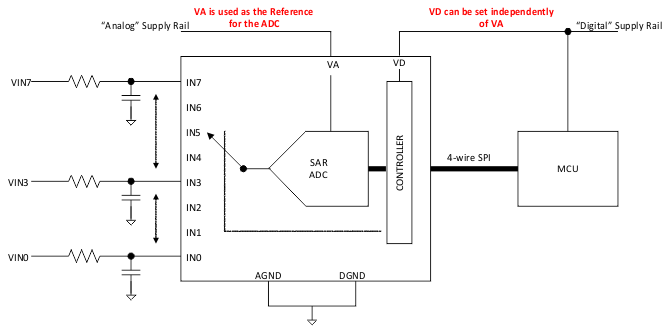
4 Revision History
Changes from F Revision (May 2013) to G Revision
- Added Pin Configuration and Functions section, ESD Ratings table, Feature Description section, Device Functional Modes, Application and Implementation section, Power Supply Recommendations section, Layout section, Device and Documentation Support section, and Mechanical, Packaging, and Orderable Information section Go
Changes from D Revision (March 2013) to E Revision
- Changed layout of National Data Sheet to TI formatGo
5 Pin Configuration and Functions

Pin Functions
| PIN | I/O | DESCRIPTION | |
|---|---|---|---|
| NO. | NAME | ||
| 3 | AGND | Supply | The ground return for the analog supply and signals. |
| 1 | CS | IN | Chip select. On the falling edge of CS, a conversion process begins. Conversions continue as long as CS is held low. |
| 12 | DGND | Supply | The ground return for the digital supply and signals. |
| 14 | DIN | IN | Digital data input. The ADC128S102's Control Register is loaded through this pin on rising edges of the SCLK pin. |
| 15 | DOUT | OUT | Digital data output. The output samples are clocked out of this pin on the falling edges of the SCLK pin. |
| 4 - 11 | IN0 to IN7 | IN | Analog inputs. These signals can range from 0 V to VREF. |
| 16 | SCLK | IN | Digital clock input. The ensured performance range of frequencies for this input is 8 MHz to 16 MHz. This clock directly controls the conversion and readout processes. |
| 2 | VA | Supply | Positive analog supply pin. This voltage is also used as the reference voltage. This pin should be connected to a quiet +2.7-V to +5.25-V source and bypassed to GND with 1-µF and 0.1-µF monolithic ceramic capacitors located within 1 cm of the power pin. |
| 13 | VD | Supply | Positive digital supply pin. This pin should be connected to a +2.7 V to VA supply, and bypassed to GND with a 0.1-µF monolithic ceramic capacitor located within 1 cm of the power pin. |
6 Specifications
6.1 Absolute Maximum Ratings
See (1)(2).| MIN | MAX | UNIT | ||
|---|---|---|---|---|
| Analog Supply Voltage VA | −0.3 | 6.5 | V | |
| Digital Supply Voltage VD | −0.3 | VA + 0.3, max 6.5 | V | |
| Voltage on Any Pin to GND | −0.3 | VA +0.3 | V | |
| Input Current at Any Pin (3) | –10 | 10 | mA | |
| Package Input Current(3) | –20 | 20 | mA | |
| Power Dissipation at TA = 25°C | See (4) | |||
| Junction Temperature | 150 | °C | ||
| Storage temperature, Tstg | −65 | 150 | °C | |
| For soldering specifications: see product folder at www.ti.com and SNOA549 | ||||
6.2 ESD Ratings
| VALUE | UNIT | |||
|---|---|---|---|---|
| V(ESD) | Electrostatic discharge | Human body model (HBM), per ANSI/ESDA/JEDEC JS-001(1) | ±2500 | V |
| Machine model (MM) | ±250 | |||
6.3 Recommended Operating Conditions
over operating free-air temperature range (unless otherwise noted)(1)| MIN | MAX | UNIT | |
|---|---|---|---|
| Operating Temperature, TA | –40 | 105 | °C |
| VA Supply Voltage | 2.7 | 5.25 | V |
| VD Supply Voltage | 2.7 | VA | V |
| Digital Input Voltage | 0 | VA | V |
| Analog Input Voltage | 0 | VA | V |
| Clock Frequency | 8 | 16 | MHz |
6.4 Thermal Information
| THERMAL METRIC(1) | ADC128S102 | UNIT | |
|---|---|---|---|
| PW | |||
| 16 PINS | |||
| RθJA | Junction-to-ambient thermal resistance | 110 | °C/W |
| RθJC(top) | Junction-to-case (top) thermal resistance | 42 | |
| RθJB | Junction-to-board thermal resistance | 56 | |
| ψJT | Junction-to-top characterization parameter | 5 | |
| ψJB | Junction-to-board characterization parameter | 55 | |
6.5 Electrical Characteristics
The following specifications apply for TA = 25°C, AGND = DGND = 0 V, fSCLK = 8 MHz to 16 MHz, fSAMPLE = 500 ksps to 1 MSPS, CL = 50pF, unless otherwise noted. MIN and MAX limits apply for TA = TMIN to TMAX.(2)| PARAMETER | TEST CONDITIONS | MIN | TYP | MAX(1) | UNIT | |
|---|---|---|---|---|---|---|
| STATIC CONVERTER CHARACTERISTICS | ||||||
| Resolution with No Missing Codes | 12 | Bits | ||||
| INL | Integral Non-Linearity (End Point Method) | VA = VD = +3.0V | –1 | ±0.4 | 1 | LSB |
| VA = VD = +5.0V | –1.2 | ±0.5 | 1.2 | LSB | ||
| DNL | Differential Non-Linearity | VA = VD = +3.0V | +0.4 | 0.9 | LSB | |
| −0.7 | −0.2 | LSB | ||||
| VA = VD = +5.0V | +0.7 | 1.5 | LSB | |||
| −0.9 | −0.4 | LSB | ||||
| VOFF | Offset Error | VA = VD = +3.0V | –2.3 | +0.8 | 2.3 | LSB |
| VA = VD = +5.0V | –2.3 | +1.1 | 2.3 | LSB | ||
| OEM | Offset Error Match | VA = VD = +3.0V | –1.5 | ±0.1 | 1.5 | LSB |
| VA = VD = +5.0V | –1.5 | ±0.3 | 1.5 | LSB | ||
| FSE | Full Scale Error | VA = VD = +3.0V | –2.0 | +0.8 | 2.0 | LSB |
| VA = VD = +5.0V | –2.0 | +0.3 | 2.0 | LSB | ||
| FSEM | Full Scale Error Match | VA = VD = +3.0V | –1.5 | ±0.1 | 1.5 | LSB |
| VA = VD = +5.0V | –1.5 | ±0.3 | 1.5 | LSB | ||
| DYNAMIC CONVERTER CHARACTERISTICS | ||||||
| FPBW | Full Power Bandwidth (−3dB) | VA = VD = +3.0V | 8 | MHz | ||
| VA = VD = +5.0V | 11 | MHz | ||||
| SINAD | Signal-to-Noise Plus Distortion Ratio | VA = VD = +3.0V, fIN = 40.2 kHz, −0.02 dBFS |
70 | 73 | dB | |
| VA = VD = +5.0V, fIN = 40.2 kHz, −0.02 dBFS |
70 | 73 | dB | |||
| SNR | Signal-to-Noise Ratio | VA = VD = +3.0V, fIN = 40.2 kHz, −0.02 dBFS |
70.8 | 73 | dB | |
| VA = VD = +5.0V, fIN = 40.2 kHz, −0.02 dBFS |
70.8 | 73 | dB | |||
| THD | Total Harmonic Distortion | VA = VD = +3.0V, fIN = 40.2 kHz, −0.02 dBFS |
−88 | −74 | dB | |
| VA = VD = +5.0V, fIN = 40.2 kHz, −0.02 dBFS |
−90 | −74 | dB | |||
| SFDR | Spurious-Free Dynamic Range | VA = VD = +3.0V, fIN = 40.2 kHz, −0.02 dBFS |
75 | 91 | dB | |
| VA = VD = +5.0V, fIN = 40.2 kHz, −0.02 dBFS |
75 | 92 | dB | |||
| ENOB | Effective Number of Bits | VA = VD = +3.0V, fIN = 40.2 kHz |
11.3 | 11.8 | Bits | |
| VA = VD = +5.0V, fIN = 40.2 kHz, −0.02 dBFS |
11.3 | 11.8 | Bits | |||
| ISO | Channel-to-Channel Isolation | VA = VD = +3.0V, fIN = 20 kHz |
82 | dB | ||
| VA = VD = +5.0V, fIN = 20 kHz, −0.02 dBFS |
84 | dB | ||||
| IMD | Intermodulation Distortion, Second Order Terms | VA = VD = +3.0V, fa = 19.5 kHz, fb = 20.5 kHz |
−89 | dB | ||
| VA = VD = +5.0V, fa = 19.5 kHz, fb = 20.5 kHz |
−91 | dB | ||||
| Intermodulation Distortion, Third Order Terms | VA = VD = +3.0V, fa = 19.5 kHz, fb = 20.5 kHz |
−88 | dB | |||
| VA = VD = +5.0V, fa = 19.5 kHz, fb = 20.5 kHz |
−88 | dB | ||||
| ANALOG INPUT CHARACTERISTICS | ||||||
| VIN | Input Range | 0 to VA | V | |||
| IDCL | DC Leakage Current | –1 | 1 | µA | ||
| CINA | Input Capacitance | Track Mode | 33 | pF | ||
| Hold Mode | 3 | pF | ||||
| DIGITAL INPUT CHARACTERISTICS | ||||||
| VIH | Input High Voltage | VA = VD = +2.7V to +3.6V | 2.1 | V | ||
| VA = VD = +4.75V to +5.25V | 2.4 | V | ||||
| VIL | Input Low Voltage | VA = VD = +2.7V to +5.25V | 0.8 | V | ||
| IIN | Input Current | VIN = 0V or VD | –1 | ±0.01 | 1 | µA |
| CIND | Digital Input Capacitance | 2 | 4 | pF | ||
| DIGITAL OUTPUT CHARACTERISTICS | ||||||
| VOH | Output High Voltage | ISOURCE = 200 µA, VA = VD = +2.7V to +5.25V |
VD − 0.5 | V | ||
| VOL | Output Low Voltage | ISINK = 200 µA to 1.0 mA, VA = VD = +2.7V to +5.25V |
0.4 | V | ||
| IOZH, IOZL | Hi-Impedance Output Leakage Current | VA = VD = +2.7V to +5.25V | –1 | 1 | µA | |
| COUT | Hi-Impedance Output Capacitance (2) | 2 | 4 | pF | ||
| Output Coding | Straight (Natural) Binary | |||||
| POWER SUPPLY CHARACTERISTICS (CL = 10 pF) | ||||||
| VA, VD | Analog and Digital Supply Voltages | VA ≥ VD | 2.7 | 5.25 | V | |
| IA + ID | Total Supply Current Normal Mode ( CS low) |
VA = VD = +2.7V to +3.6V, fSAMPLE = 1 MSPS, fIN = 40 kHz |
0.76 | 1.5 | mA | |
| VA = VD = +4.75V to +5.25V, fSAMPLE = 1 MSPS, fIN = 40 kHz |
2.13 | 3.1 | mA | |||
| Total Supply Current Shutdown Mode (CS high) |
VA = VD = +2.7V to +3.6V, fSCLK = 0 ksps |
20 | nA | |||
| VA = VD = +4.75V to +5.25V, fSCLK = 0 ksps |
50 | nA | ||||
| PC | Power Consumption Normal Mode ( CS low) |
VA = VD = +3.0V fSAMPLE = 1 MSPS, fIN = 40 kHz |
2.3 | 4.5 | mW | |
| VA = VD = +5.0V fSAMPLE = 1 MSPS, fIN = 40 kHz |
10.7 | 15.5 | mW | |||
| Power Consumption Shutdown Mode (CS high) |
VA = VD = +3.0V fSCLK = 0 ksps |
0.06 | µW | |||
| VA = VD = +5.0V fSCLK = 0 ksps |
0.25 | µW | ||||
| AC ELECTRICAL CHARACTERISTICS | ||||||
| fSCLKMIN | Minimum Clock Frequency | VA = VD = +2.7V to +5.25V | 8 | 0.8 | MHz | |
| fSCLK | Maximum Clock Frequency | VA = VD = +2.7V to +5.25V | 16 | MHz | ||
| fS | Sample Rate Continuous Mode |
VA = VD = +2.7V to +5.25V | 500 | 50 | ksps | |
| 1 | MSPS | |||||
| tCONVERT | Conversion (Hold) Time | VA = VD = +2.7V to +5.25V | 13 | SCLK cycles | ||
| DC | SCLK Duty Cycle | VA = VD = +2.7V to +5.25V | 40% | 30 | ||
| 70 | 60% | |||||
| tACQ | Acquisition (Track) Time | VA = VD = +2.7V to +5.25V | 3 | SCLK cycles | ||
| Throughput Time | Acquisition Time + Conversion Time VA = VD = +2.7V to +5.25V |
16 | SCLK cycles | |||
| tAD | Aperture Delay | VA = VD = +2.7V to +5.25V | 4 | ns | ||
6.6 Timing Specifications
The following specifications apply for TA = 25°C, VA = VD = +2.7V to +5.25V, AGND = DGND = 0V, fSCLK = 8 MHz to 16 MHz, fSAMPLE = 500 ksps to 1 MSPS, and CL = 50pF. MIN and MAX apply for TA = TMIN to TMAX.| PARAMETER | TEST CONDITIONS | MIN | TYP | MAX(1) | UNIT | |
|---|---|---|---|---|---|---|
| tCSH | CS Hold Time after SCLK Rising Edge | 10 | 0 | ns | ||
| tCSS | CS Setup Time prior to SCLK Rising Edge | 10 | 4.5 | ns | ||
| tEN | CS Falling Edge to DOUT enabled | 5 | 30 | ns | ||
| tDACC | DOUT Access Time after SCLK Falling Edge | 17 | 27 | ns | ||
| tDHLD | DOUT Hold Time after SCLK Falling Edge | 4 | ns | |||
| tDS | DIN Setup Time prior to SCLK Rising Edge | 10 | 3 | ns | ||
| tDH | DIN Hold Time after SCLK Rising Edge | 10 | 3 | ns | ||
| tCH | SCLK High Time | 0.4 x tSCLK | ns | |||
| tCL | SCLK Low Time | 0.4 x tSCLK | ns | |||
| tDIS | CS Rising Edge to DOUT High-Impedance | DOUT falling | 2.4 | 20 | ns | |
| DOUT rising | 0.9 | 20 | ns | |||
 Figure 1. ADC128S102 Operational Timing Diagram
Figure 1. ADC128S102 Operational Timing Diagram
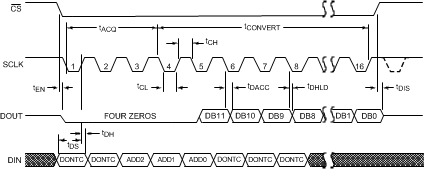 Figure 2. ADC128S102 Serial Timing Diagram
Figure 2. ADC128S102 Serial Timing Diagram
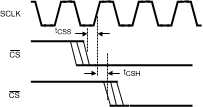 Figure 3. SCLK and CS Timing Parameters
Figure 3. SCLK and CS Timing Parameters
6.7 Typical Characteristics
TA = +25°C, fSAMPLE = 1 MSPS, fSCLK = 16 MHz, fIN = 40.2 kHz unless otherwise stated.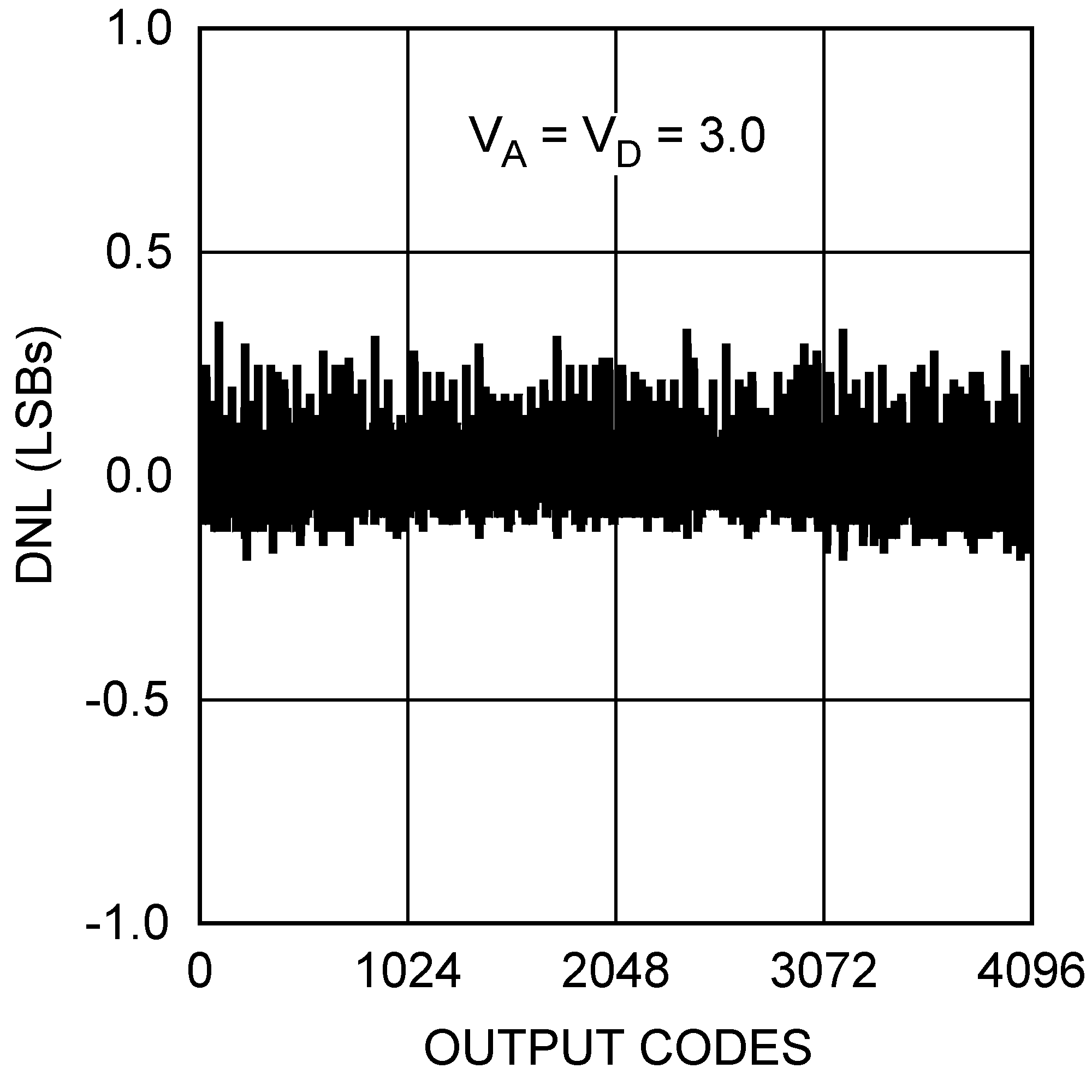 Figure 4. DNL
Figure 4. DNL
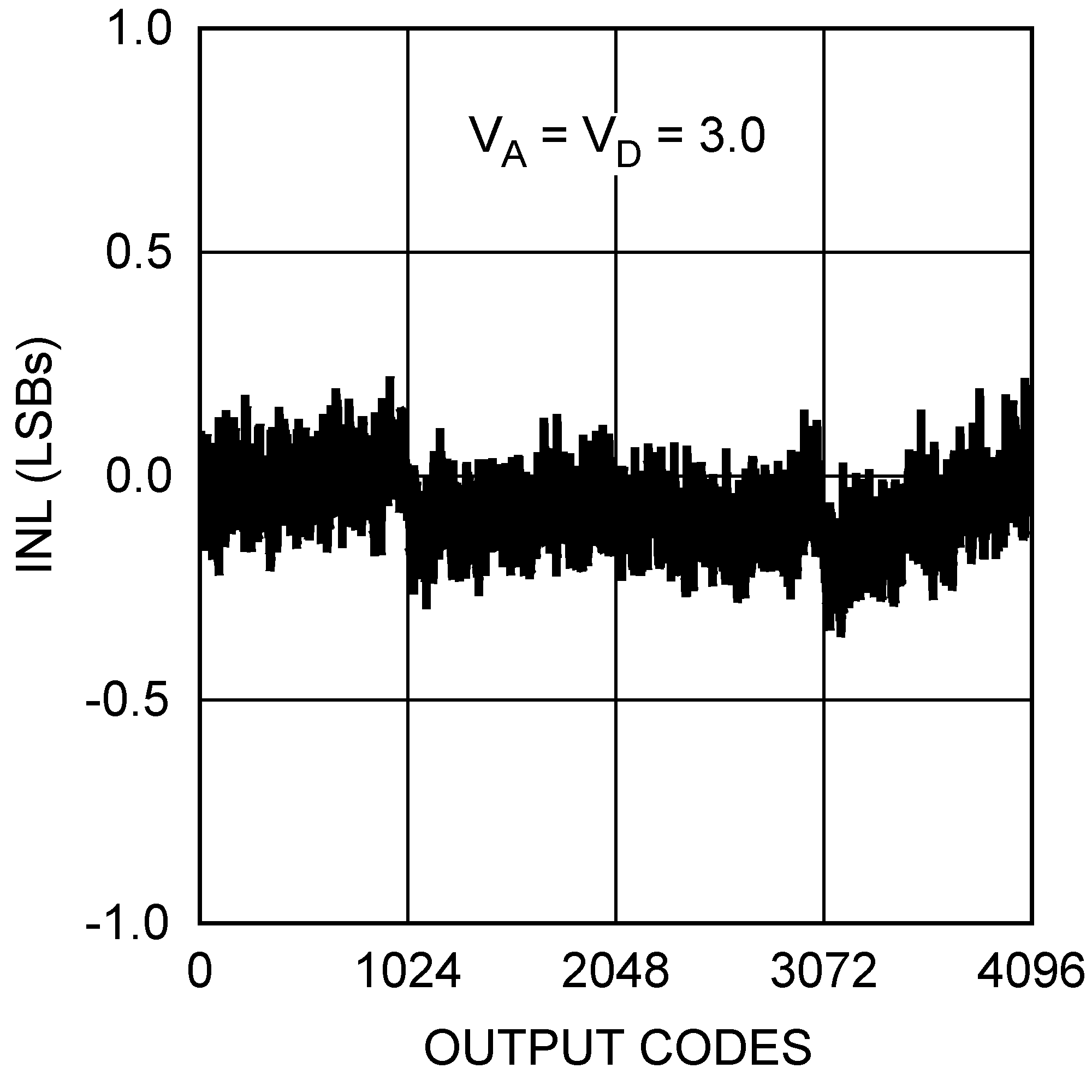 Figure 6. INL
Figure 6. INL
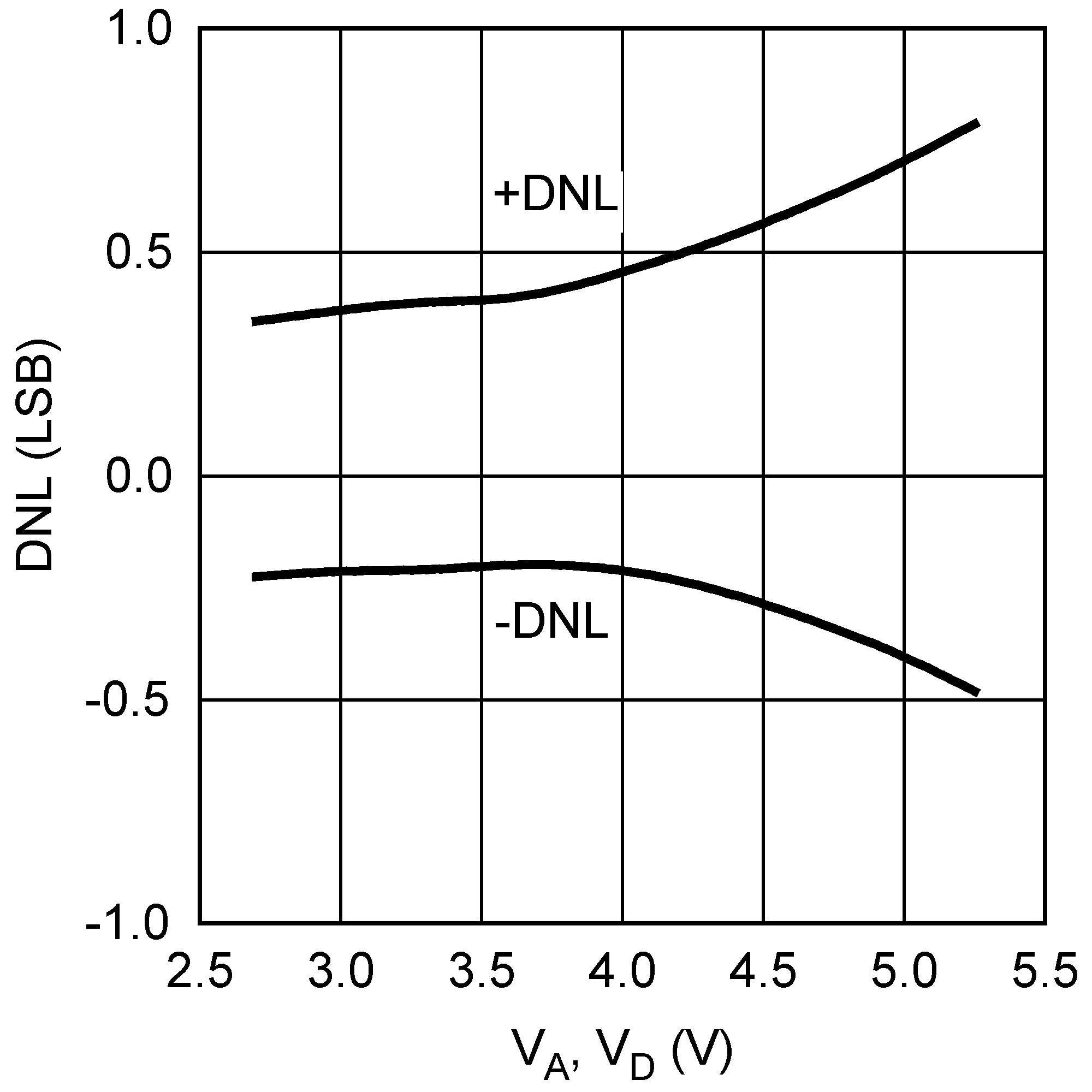 Figure 8. DNL vs. Supply
Figure 8. DNL vs. Supply
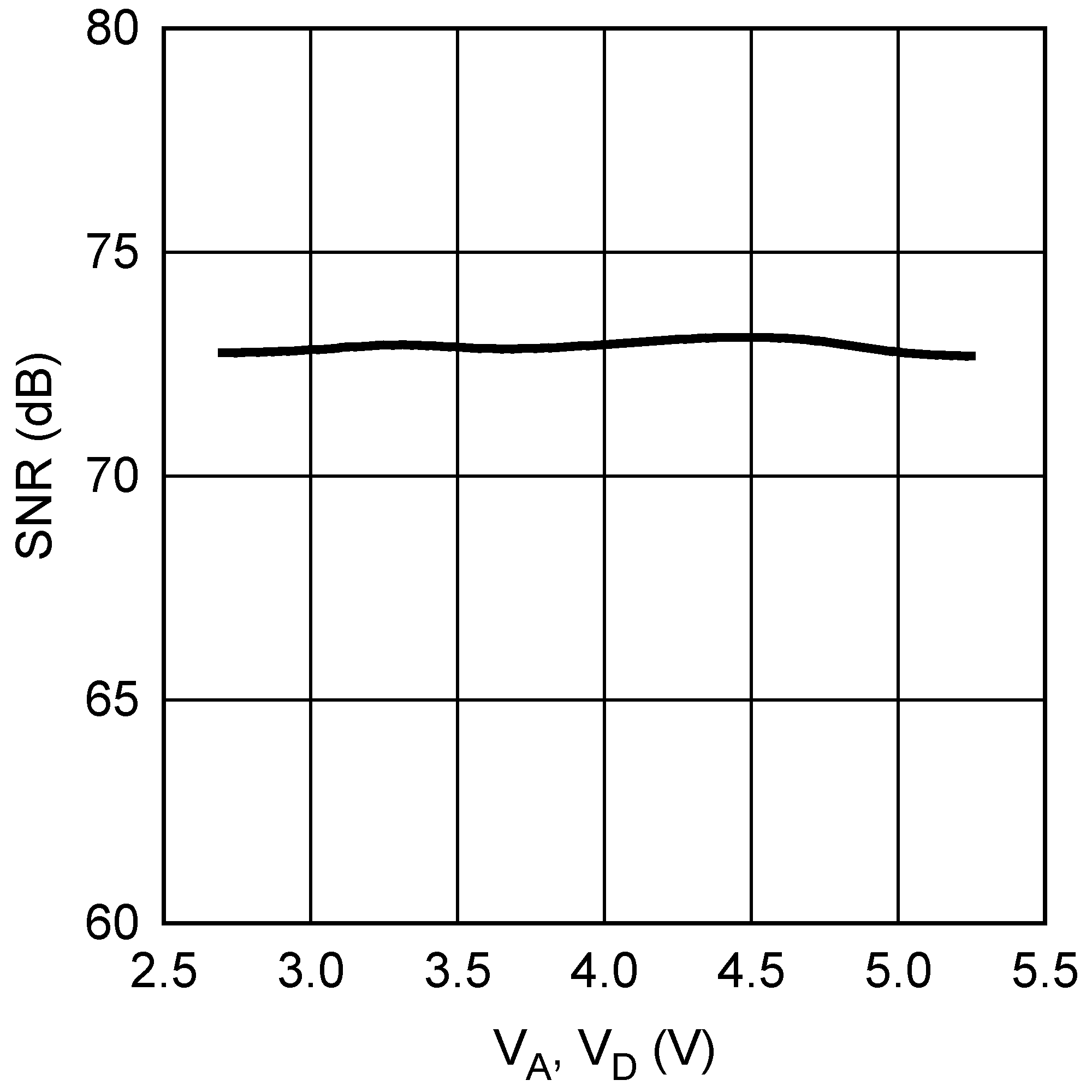 Figure 10. SNR vs. Supply
Figure 10. SNR vs. Supply
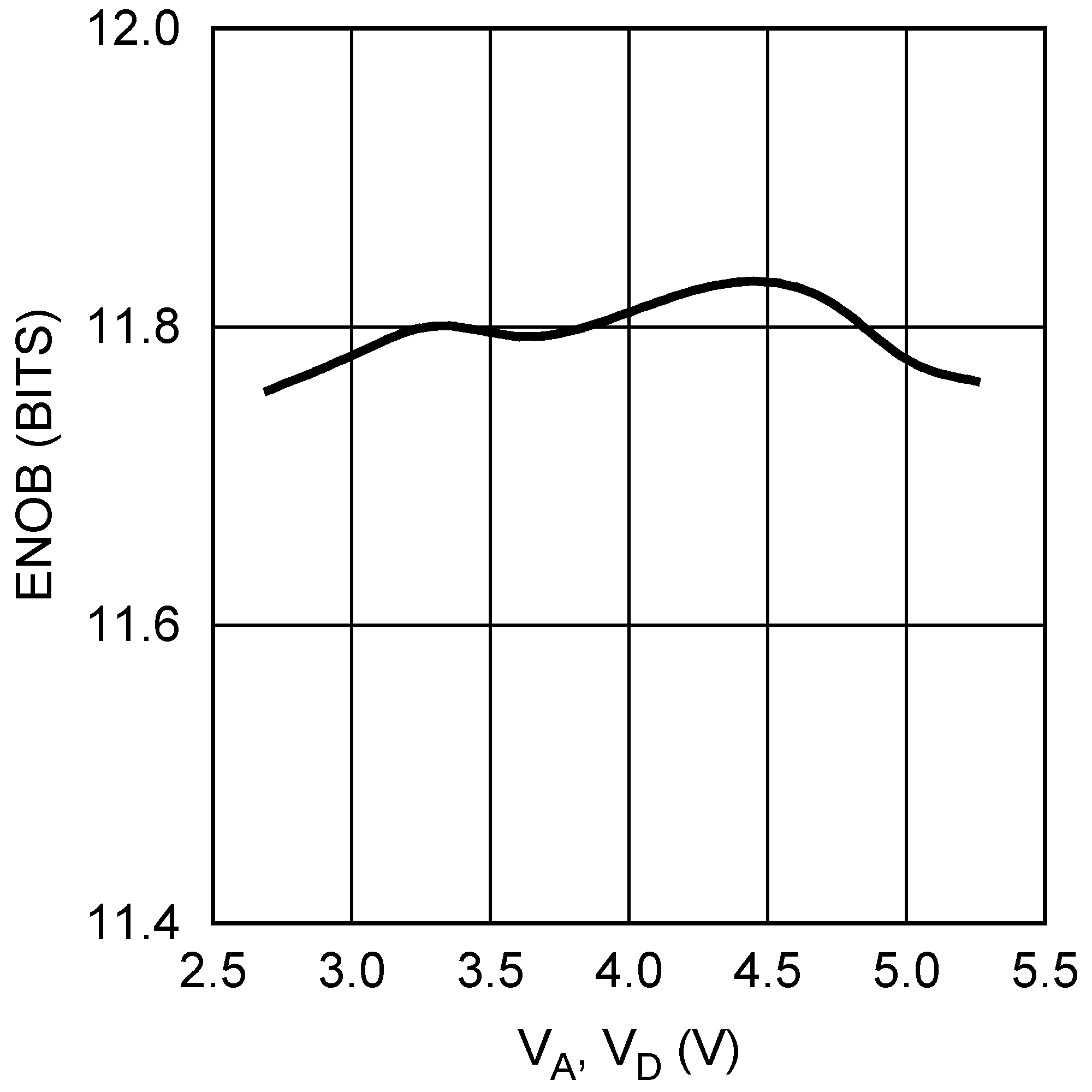 Figure 12. ENOB vs. Supply
Figure 12. ENOB vs. Supply
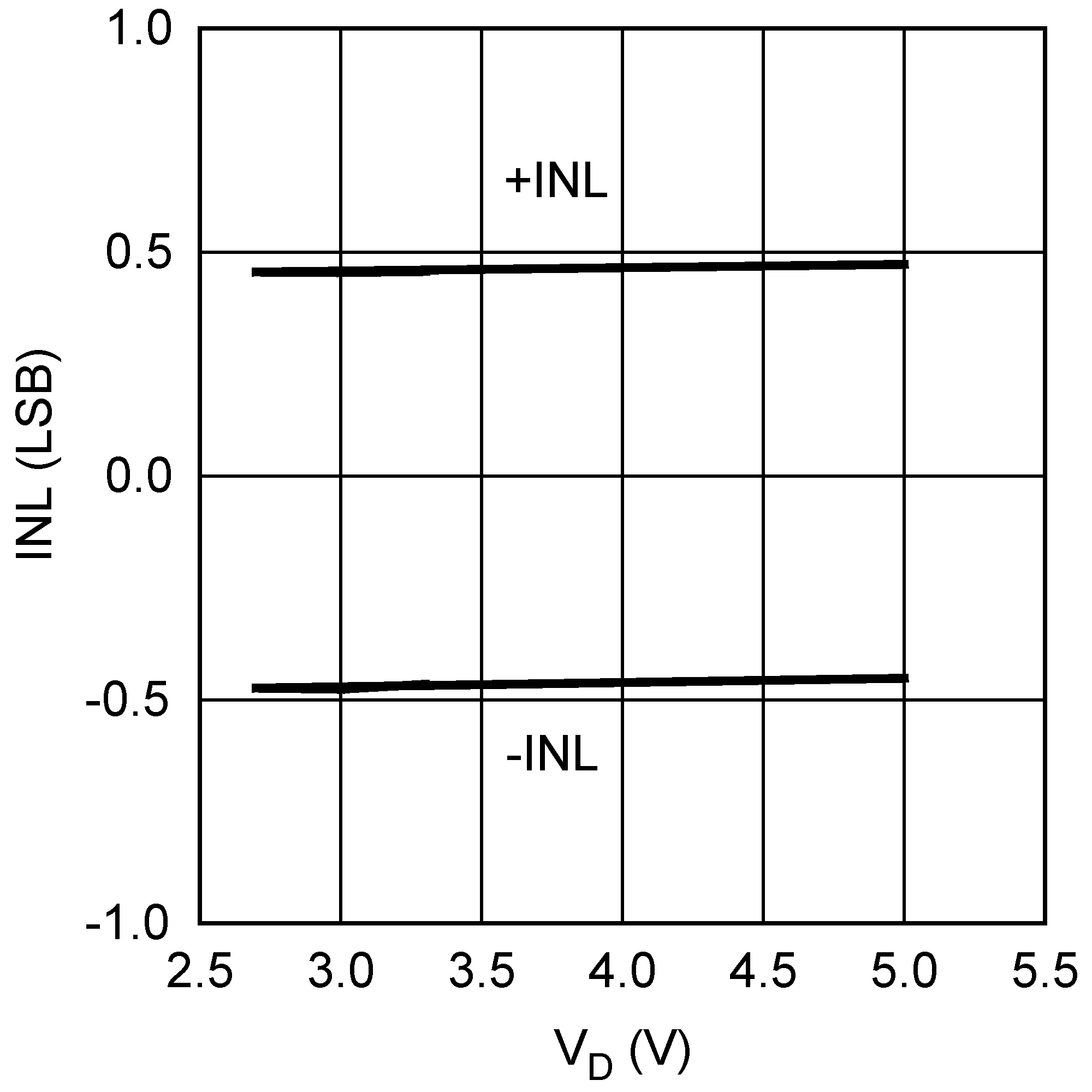 Figure 14. INL vs. VD with VA = 5.0 V
Figure 14. INL vs. VD with VA = 5.0 V
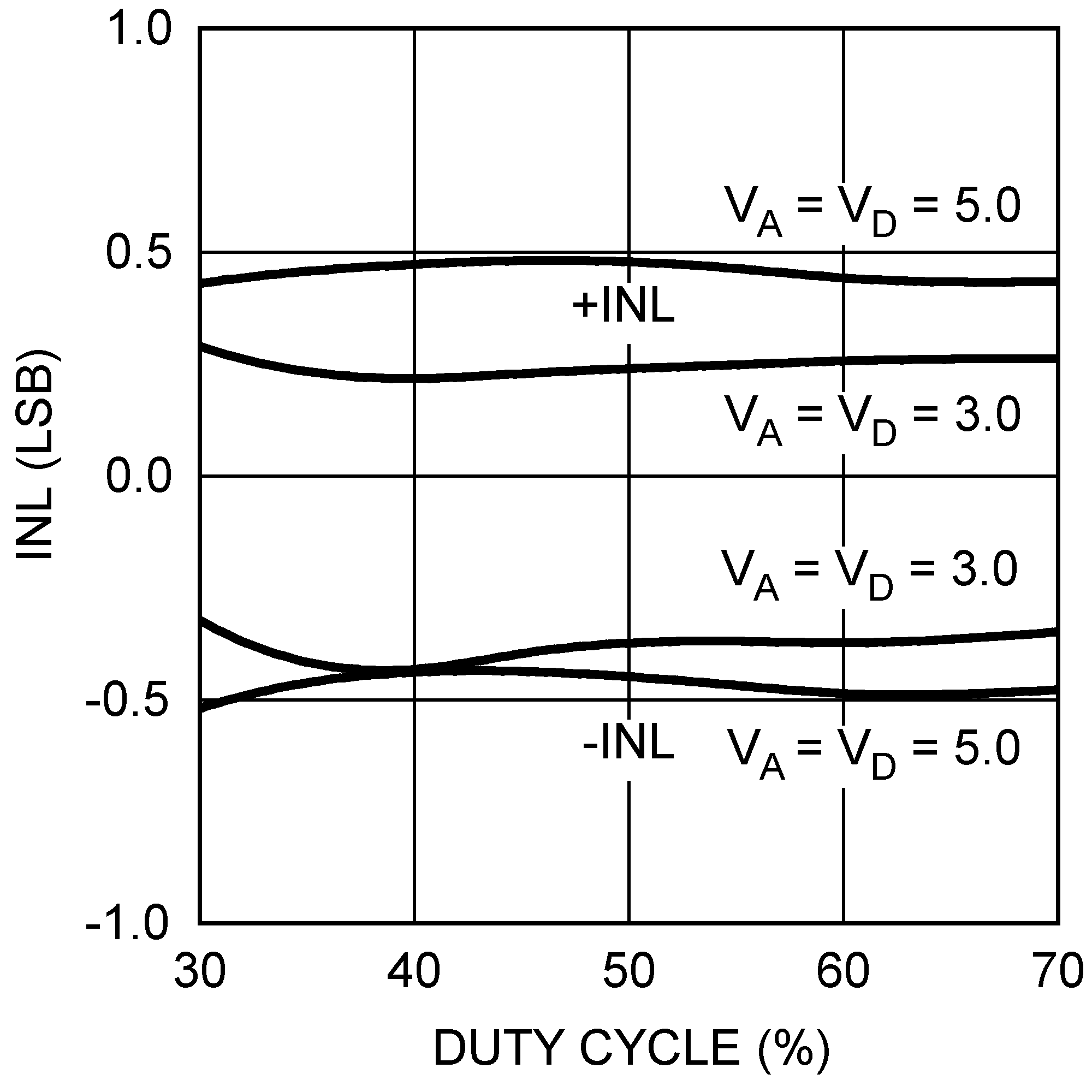 Figure 16. INL vs. SCLK Duty Cycle
Figure 16. INL vs. SCLK Duty Cycle
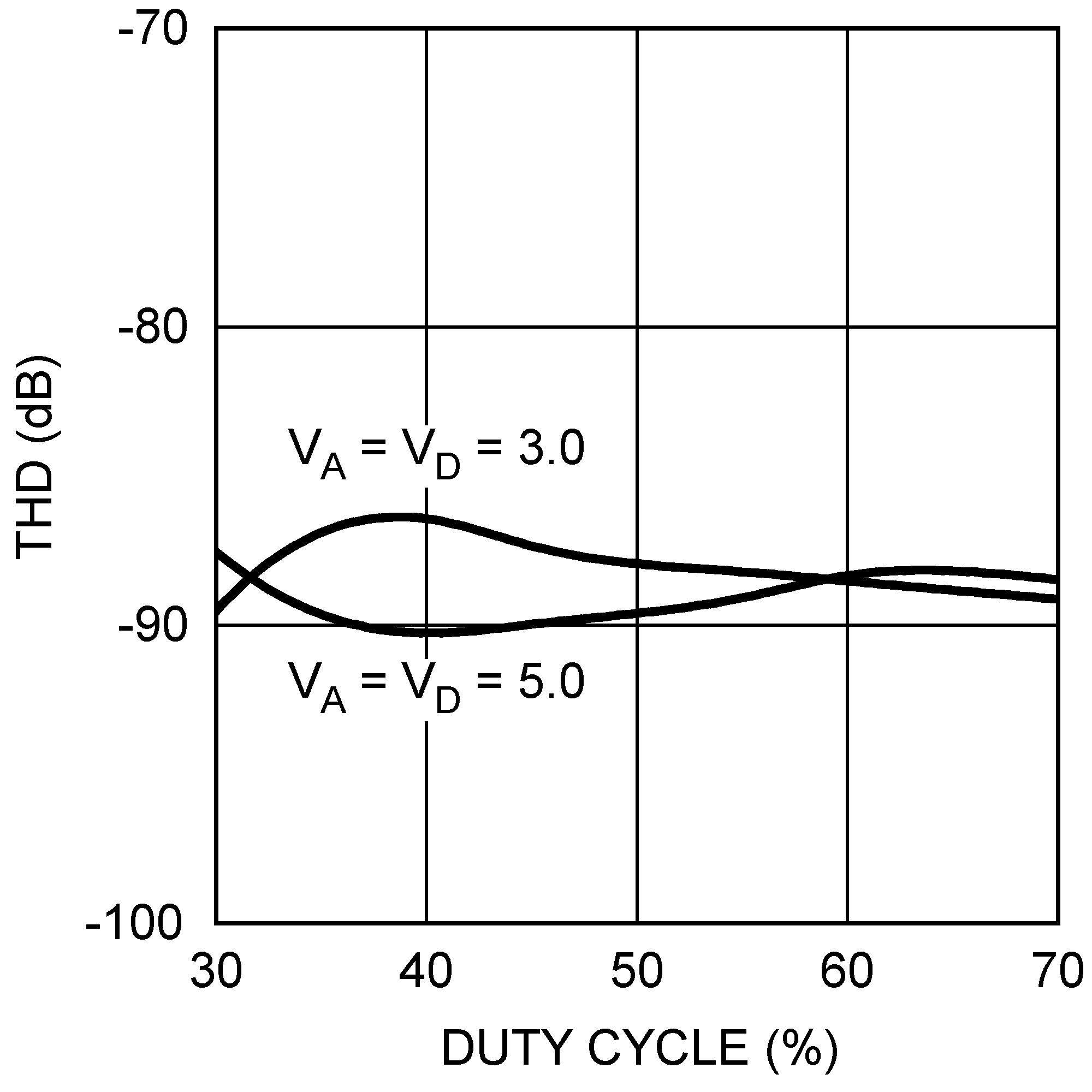 Figure 18. THD vs. SCLK Duty Cycle
Figure 18. THD vs. SCLK Duty Cycle
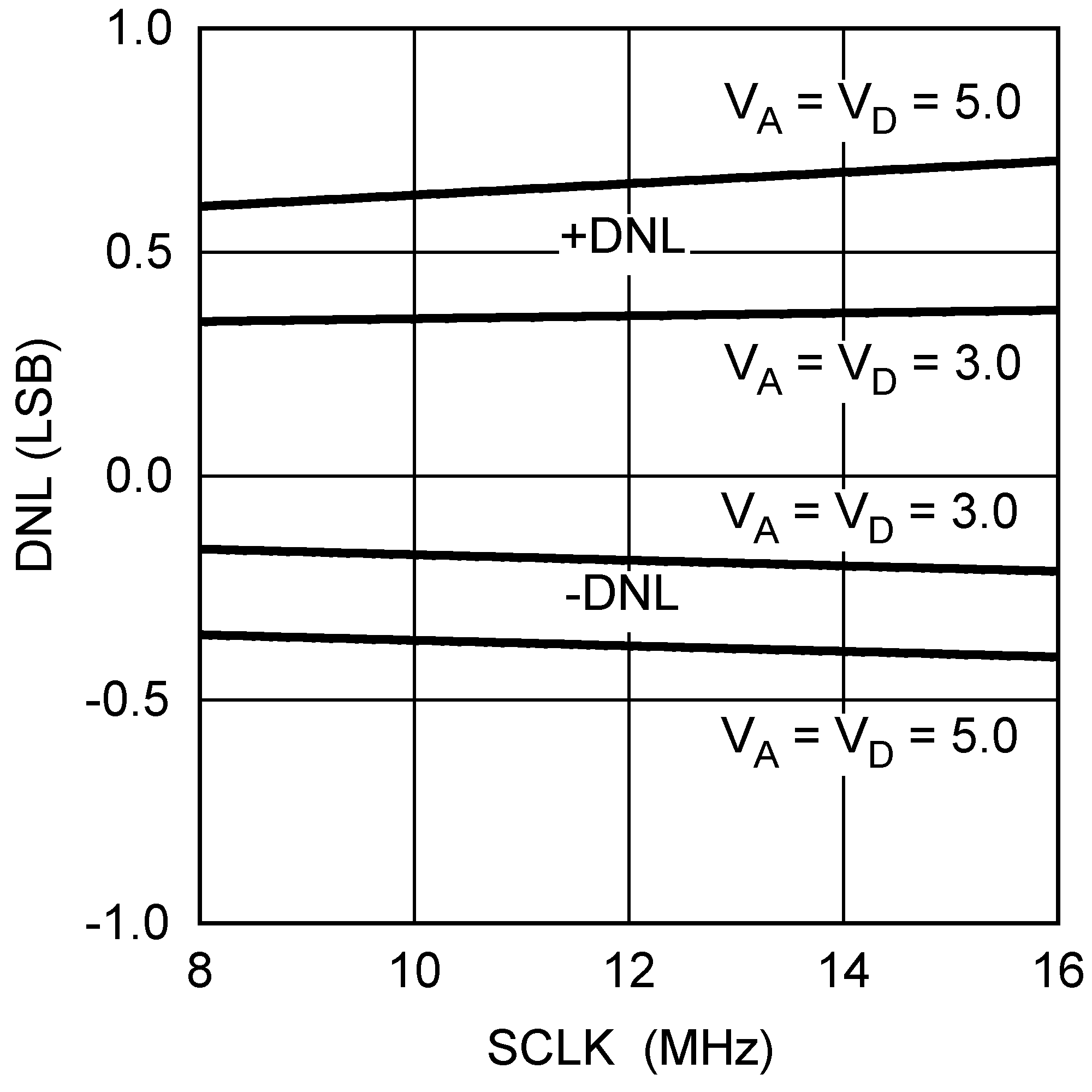 Figure 20. DNL vs. SCLK
Figure 20. DNL vs. SCLK
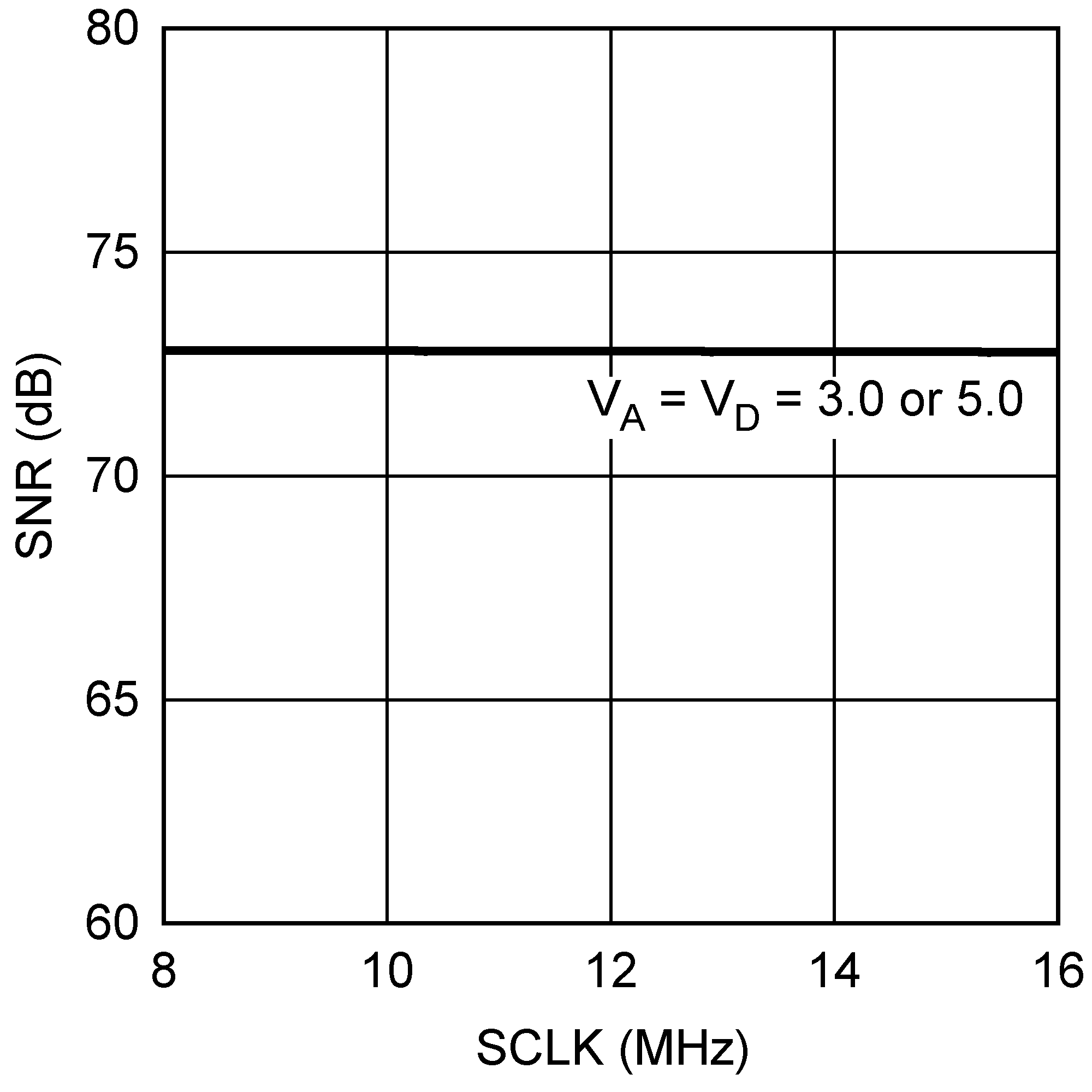 Figure 22. SNR vs. SCLK
Figure 22. SNR vs. SCLK
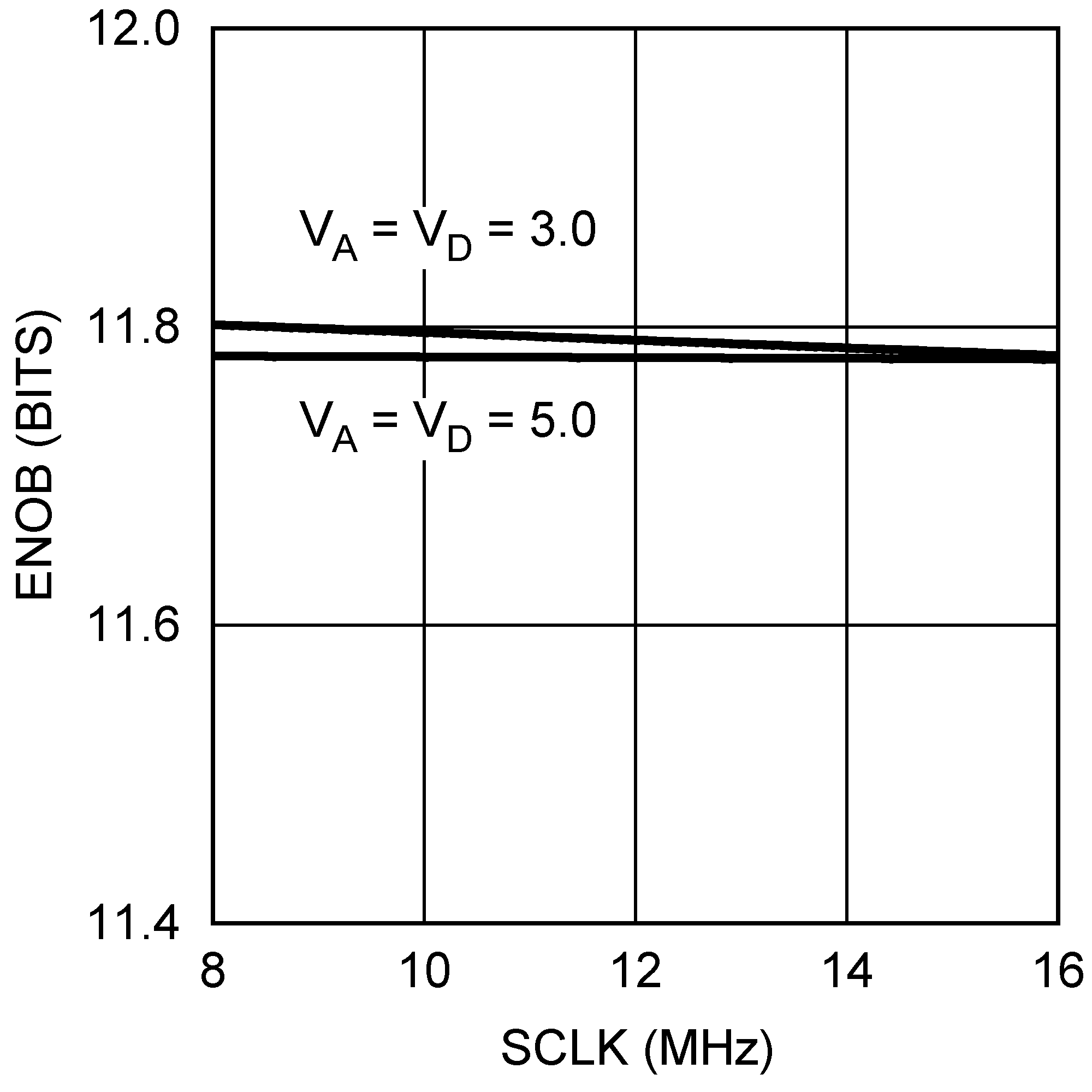 Figure 24. ENOB vs. SCLK
Figure 24. ENOB vs. SCLK
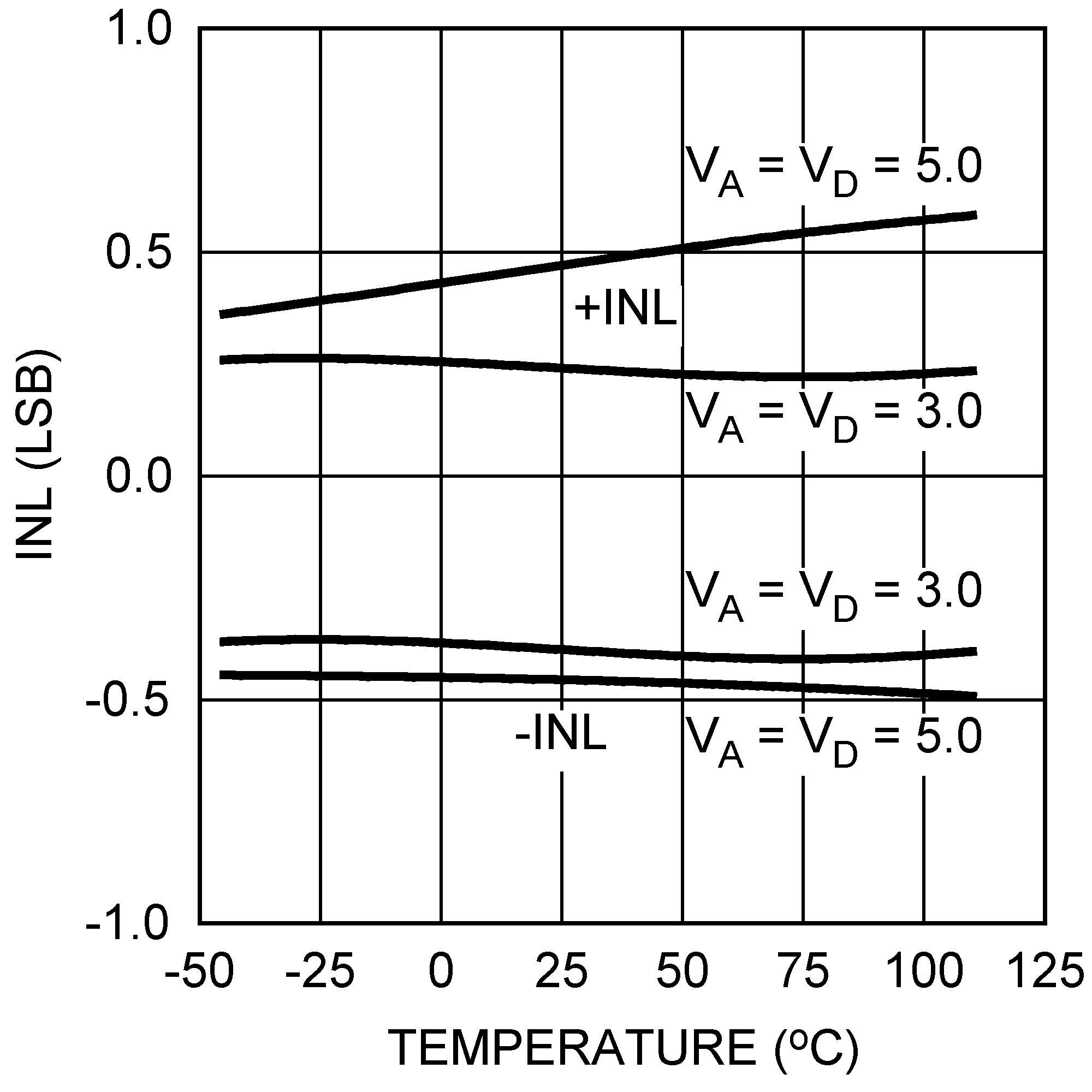 Figure 26. INL vs. Temperature
Figure 26. INL vs. Temperature
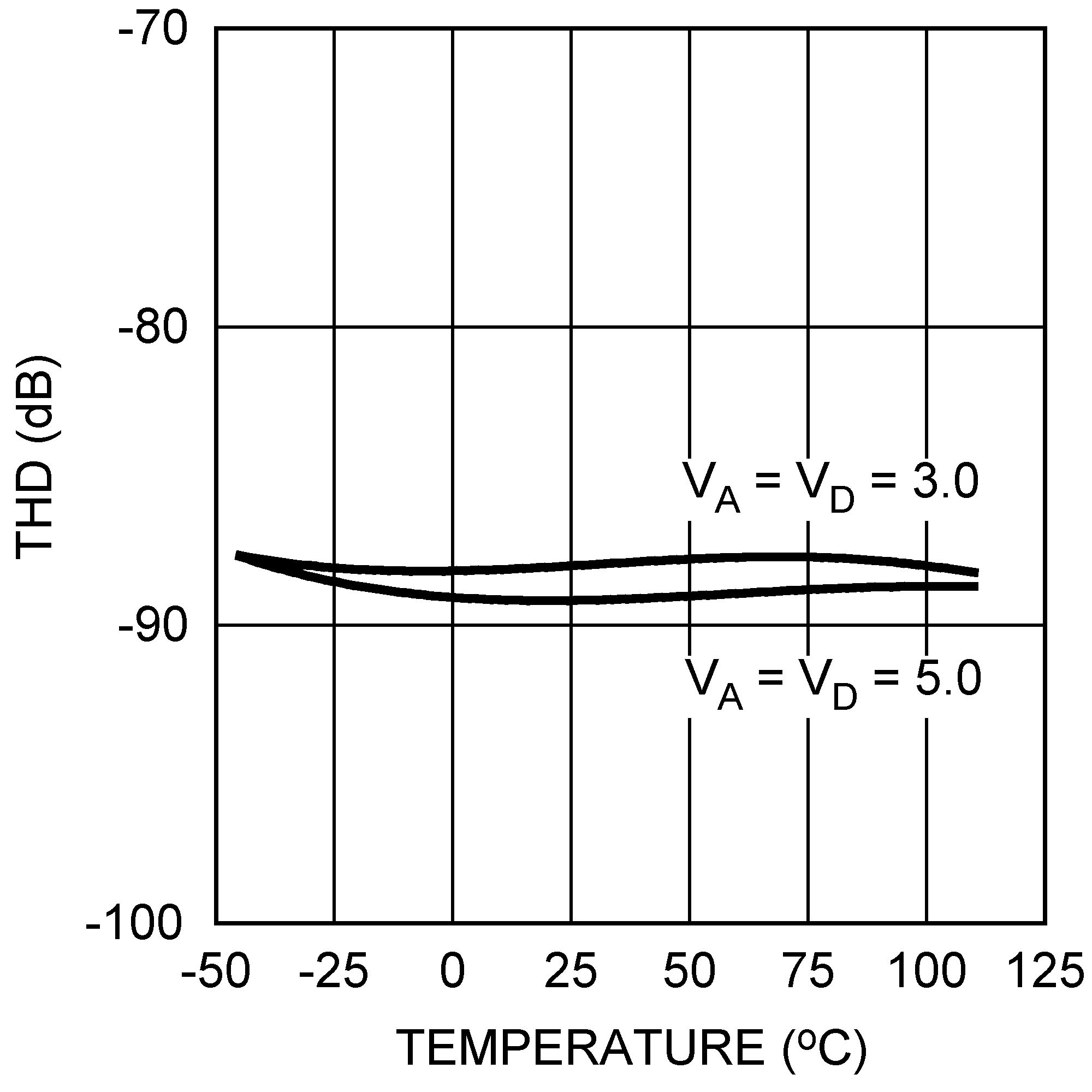 Figure 28. THD vs. Temperature
Figure 28. THD vs. Temperature
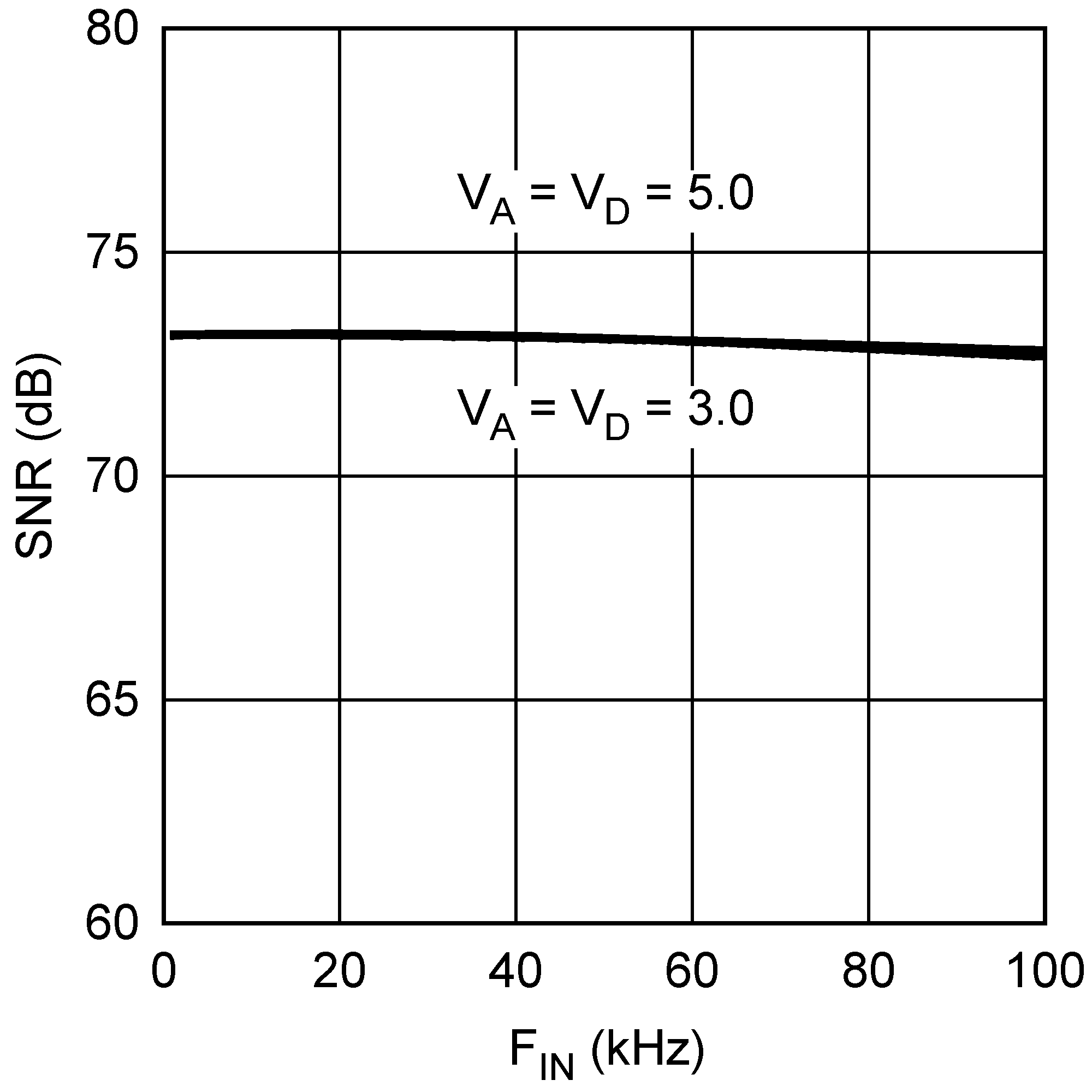 Figure 30. SNR vs. Input Frequency
Figure 30. SNR vs. Input Frequency
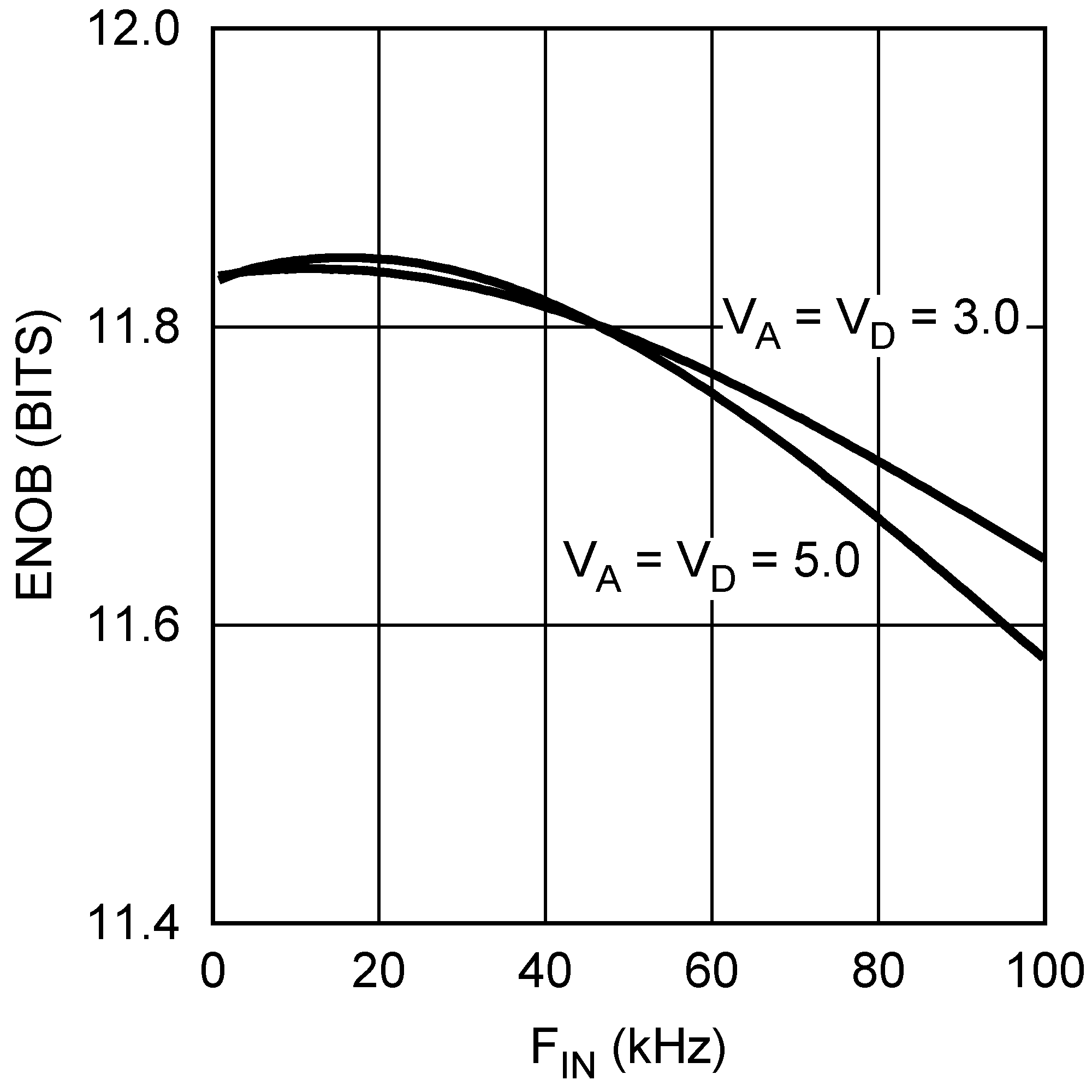 Figure 32. ENOB vs. Input Frequency
Figure 32. ENOB vs. Input Frequency
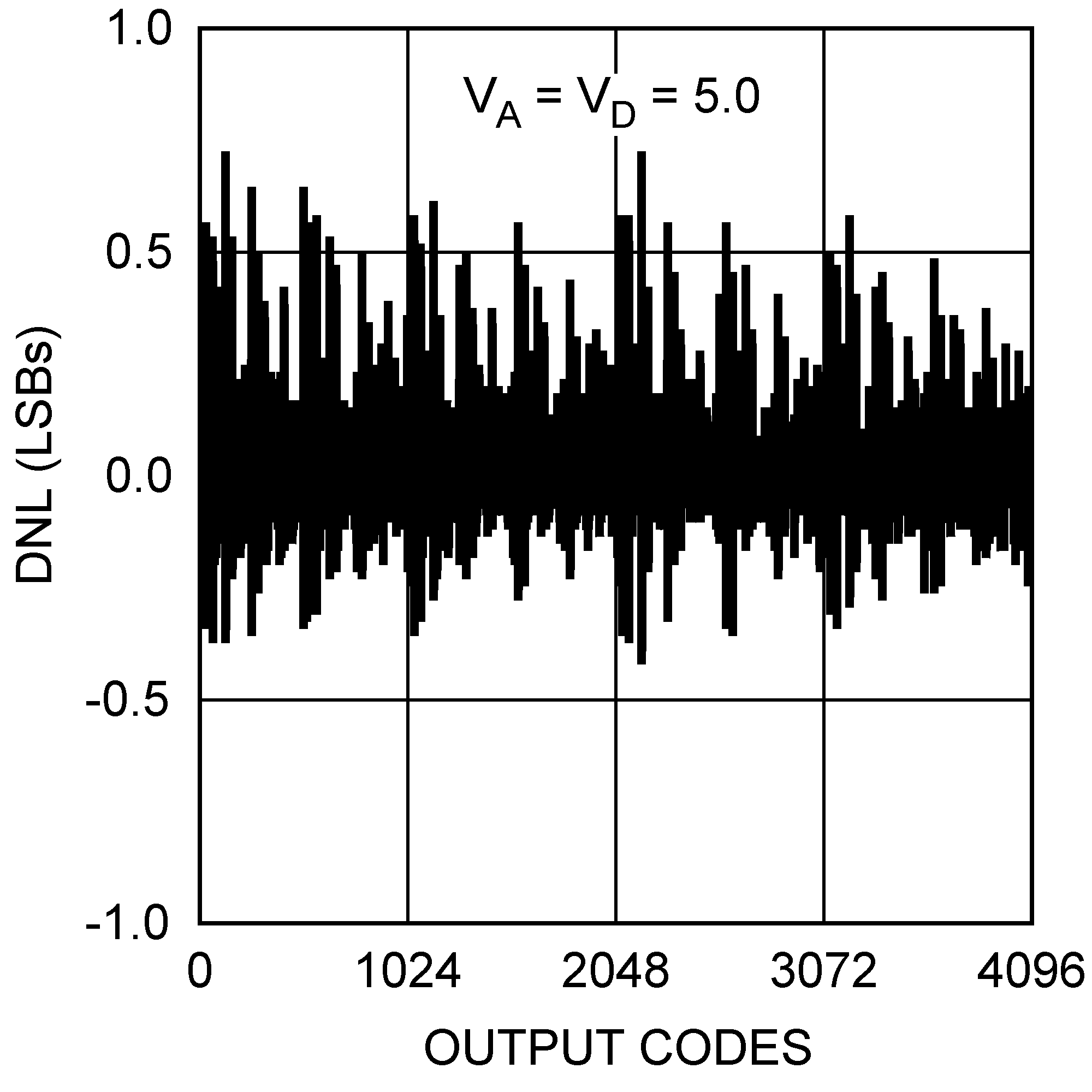 Figure 5. DNL
Figure 5. DNL
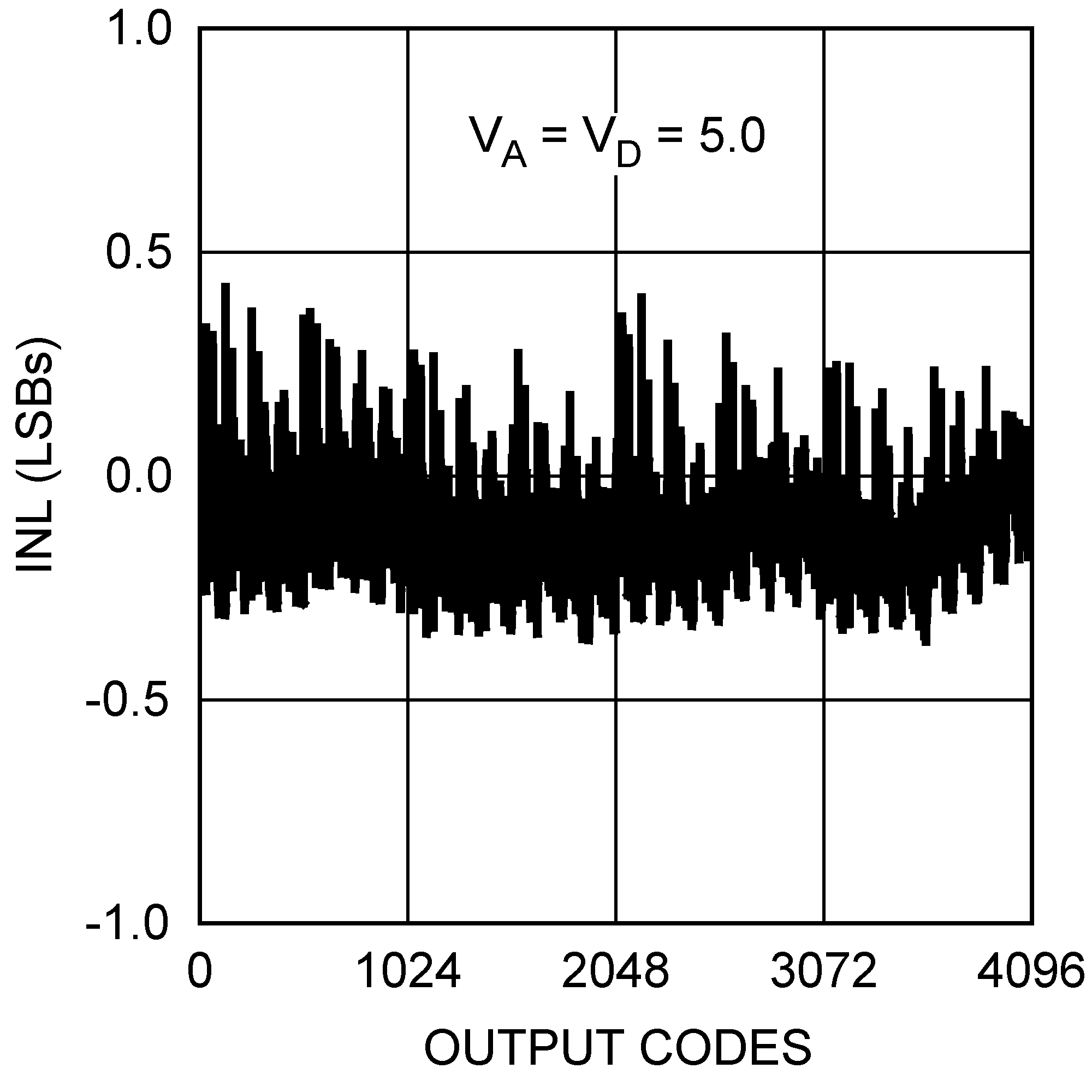 Figure 7. INL
Figure 7. INL
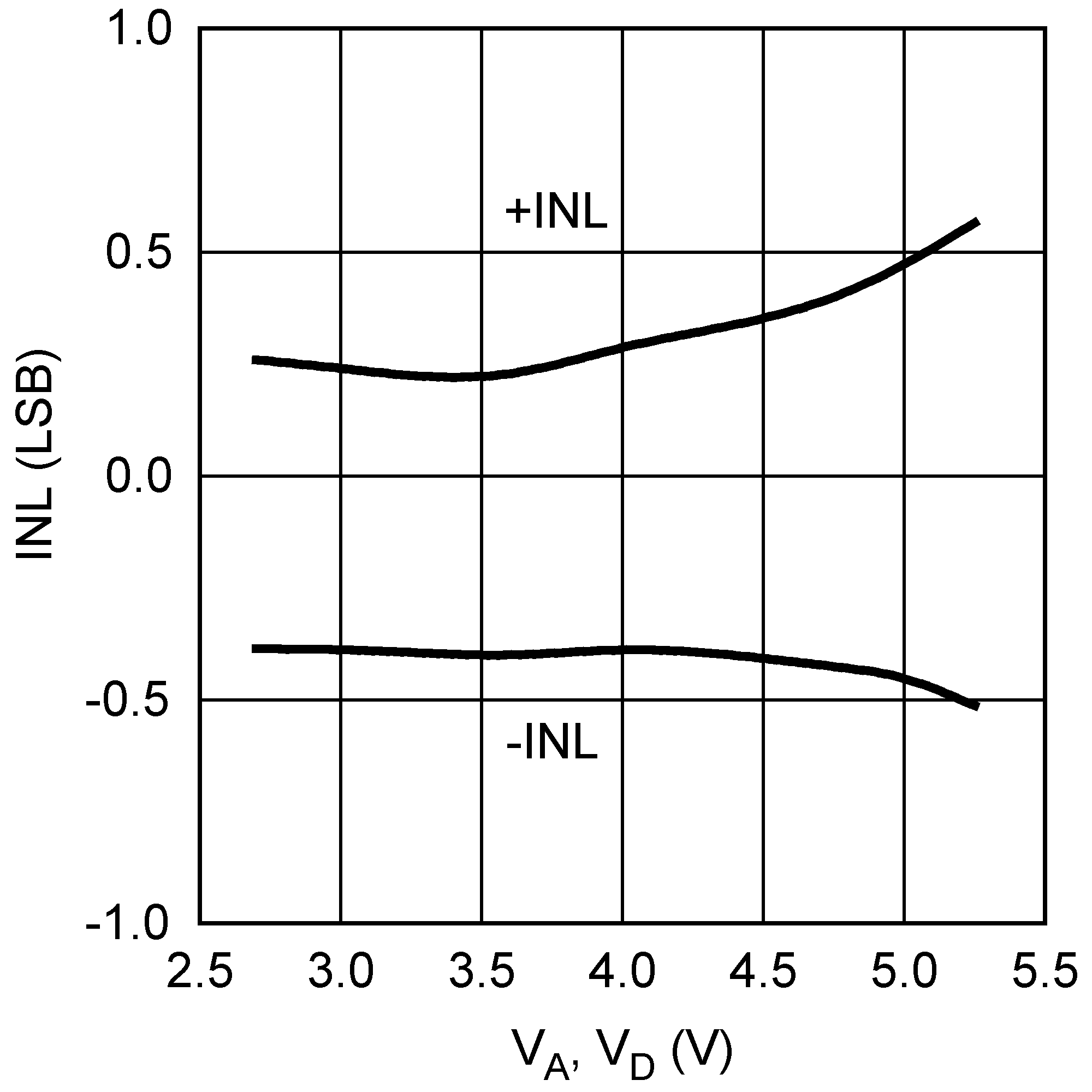 Figure 9. INL vs. Supply
Figure 9. INL vs. Supply
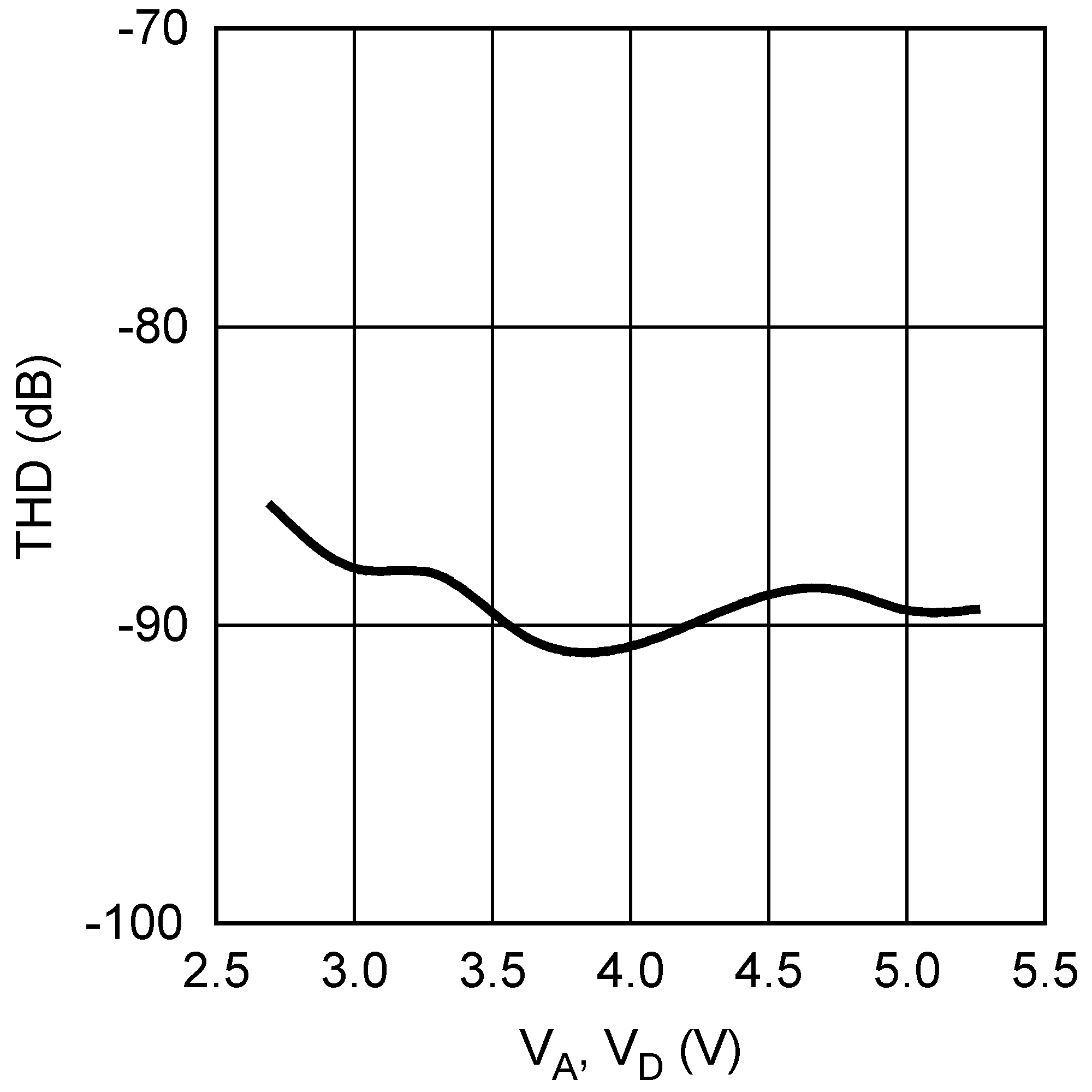 Figure 11. THD vs. Supply
Figure 11. THD vs. Supply
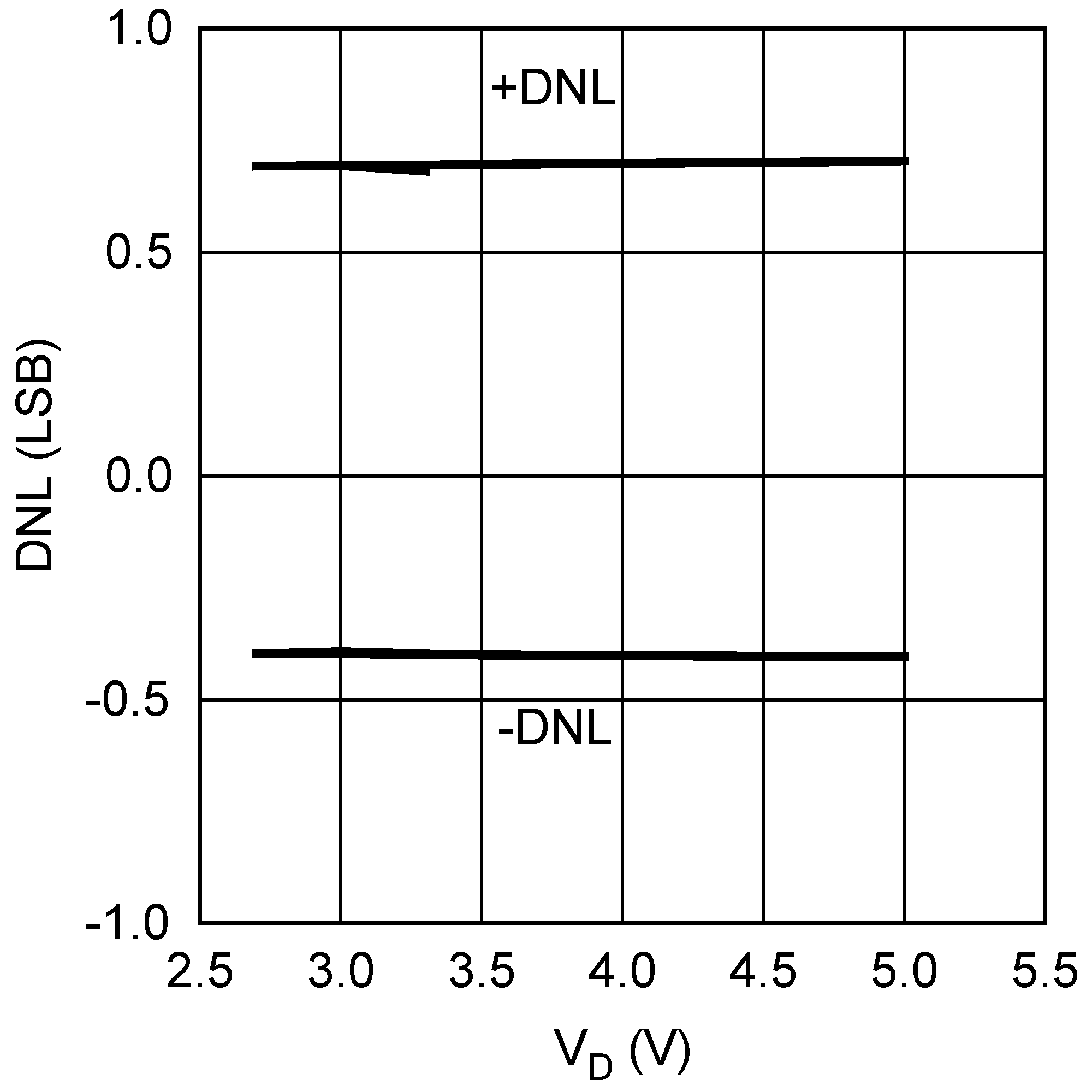 Figure 13. DNL vs. VD with VA = 5.0 V
Figure 13. DNL vs. VD with VA = 5.0 V
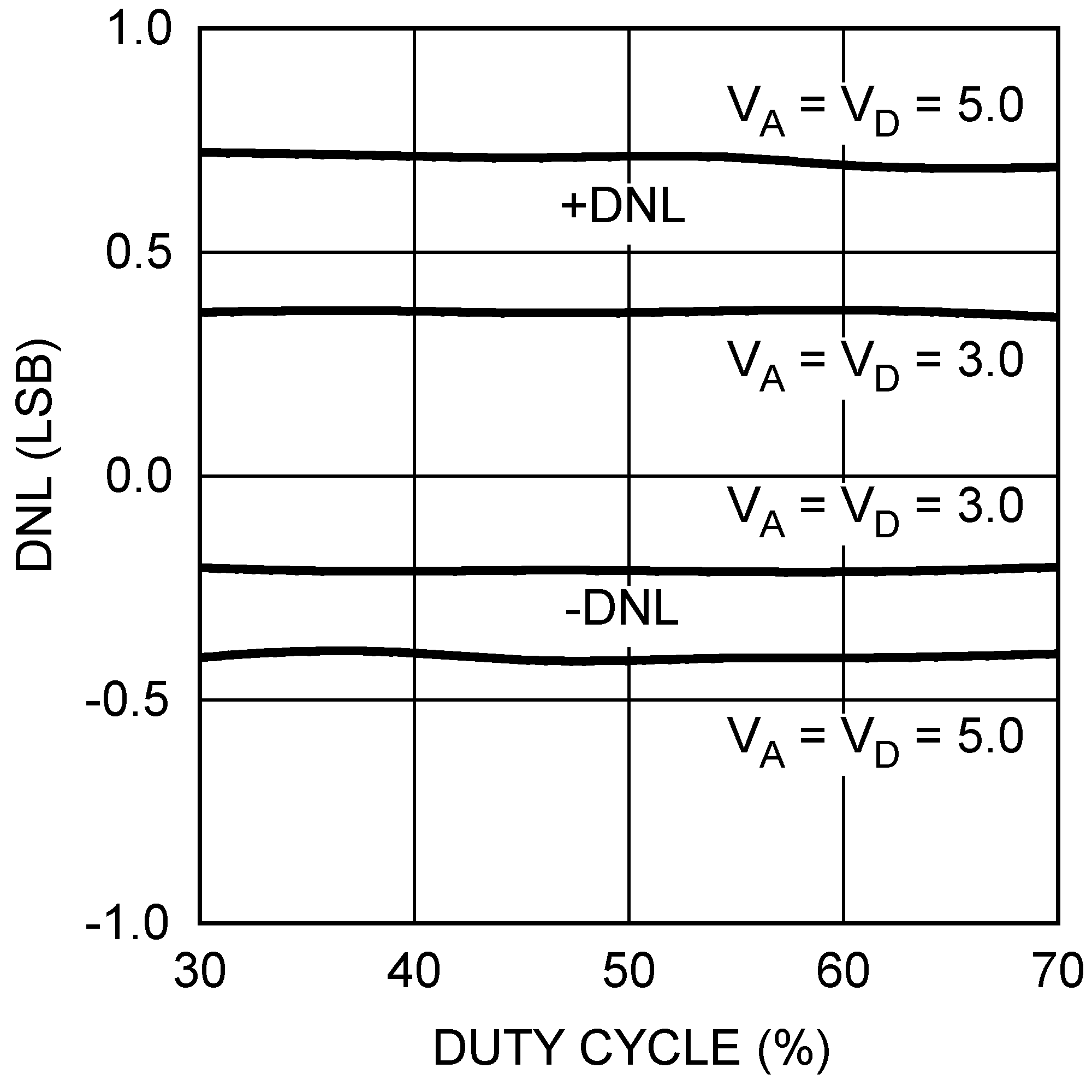 Figure 15. DNL vs. SCLK Duty Cycle
Figure 15. DNL vs. SCLK Duty Cycle
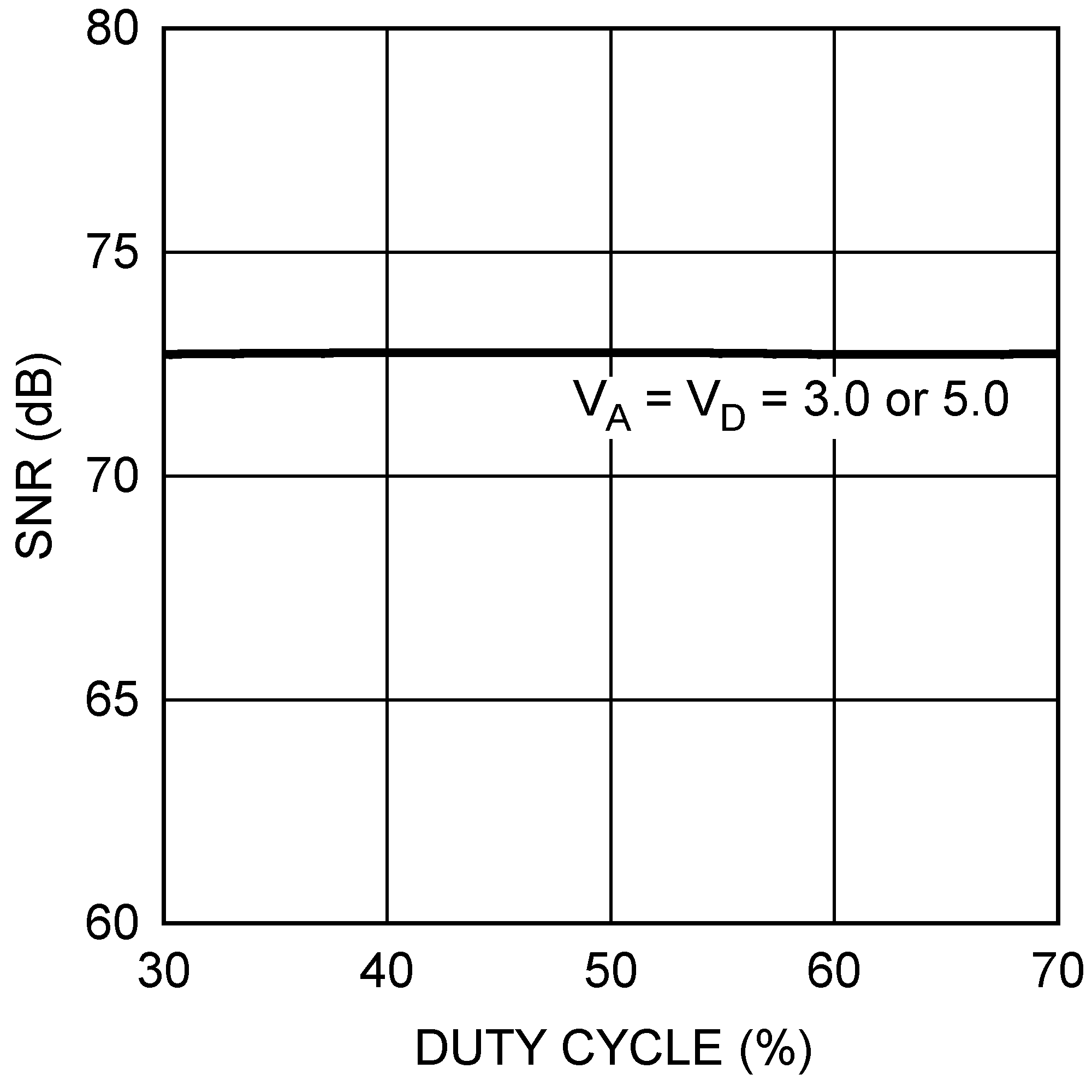 Figure 17. SNR vs. SCLK Duty Cycle
Figure 17. SNR vs. SCLK Duty Cycle
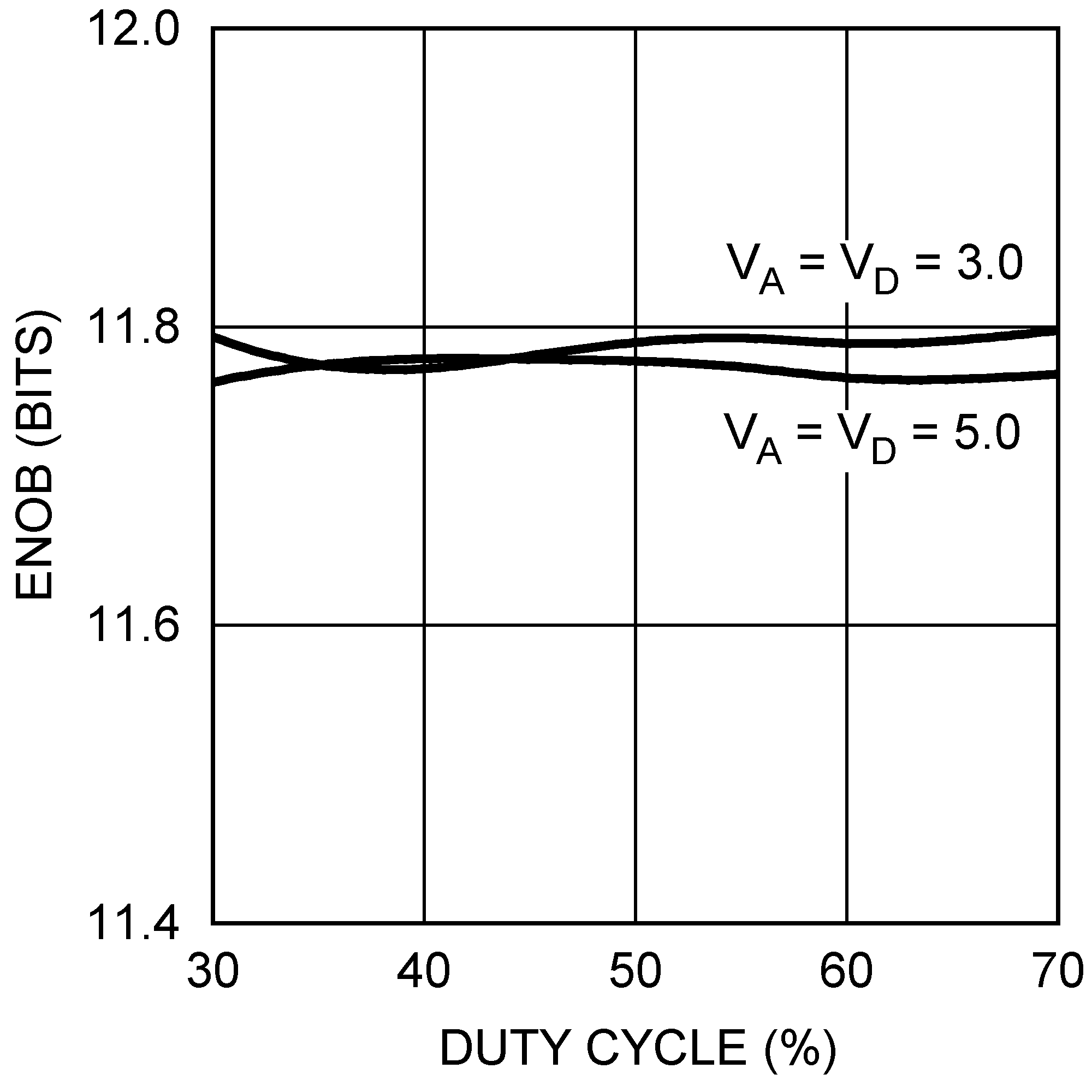 Figure 19. ENOB vs. SCLK Duty Cycle
Figure 19. ENOB vs. SCLK Duty Cycle
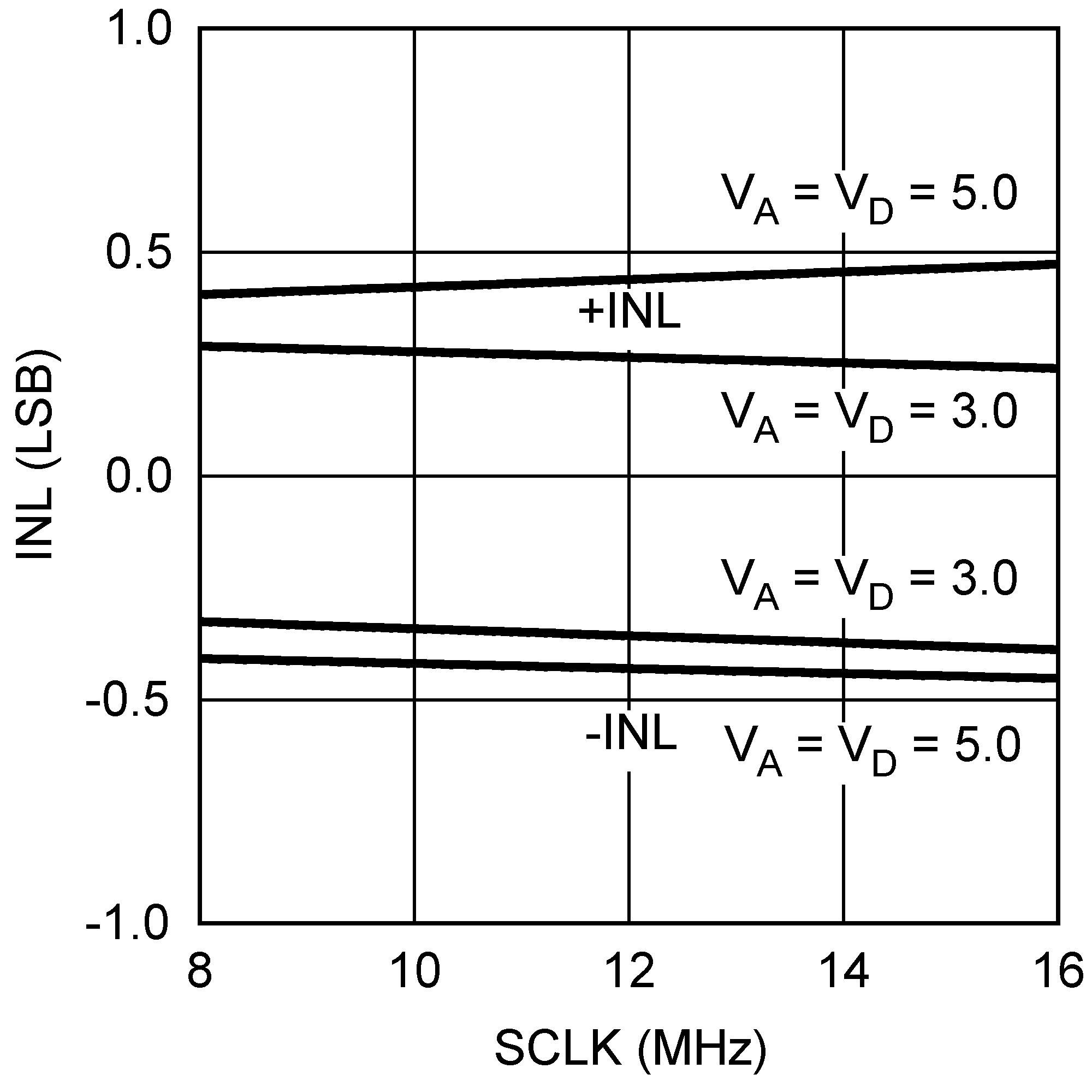 Figure 21. INL vs. SCLK
Figure 21. INL vs. SCLK
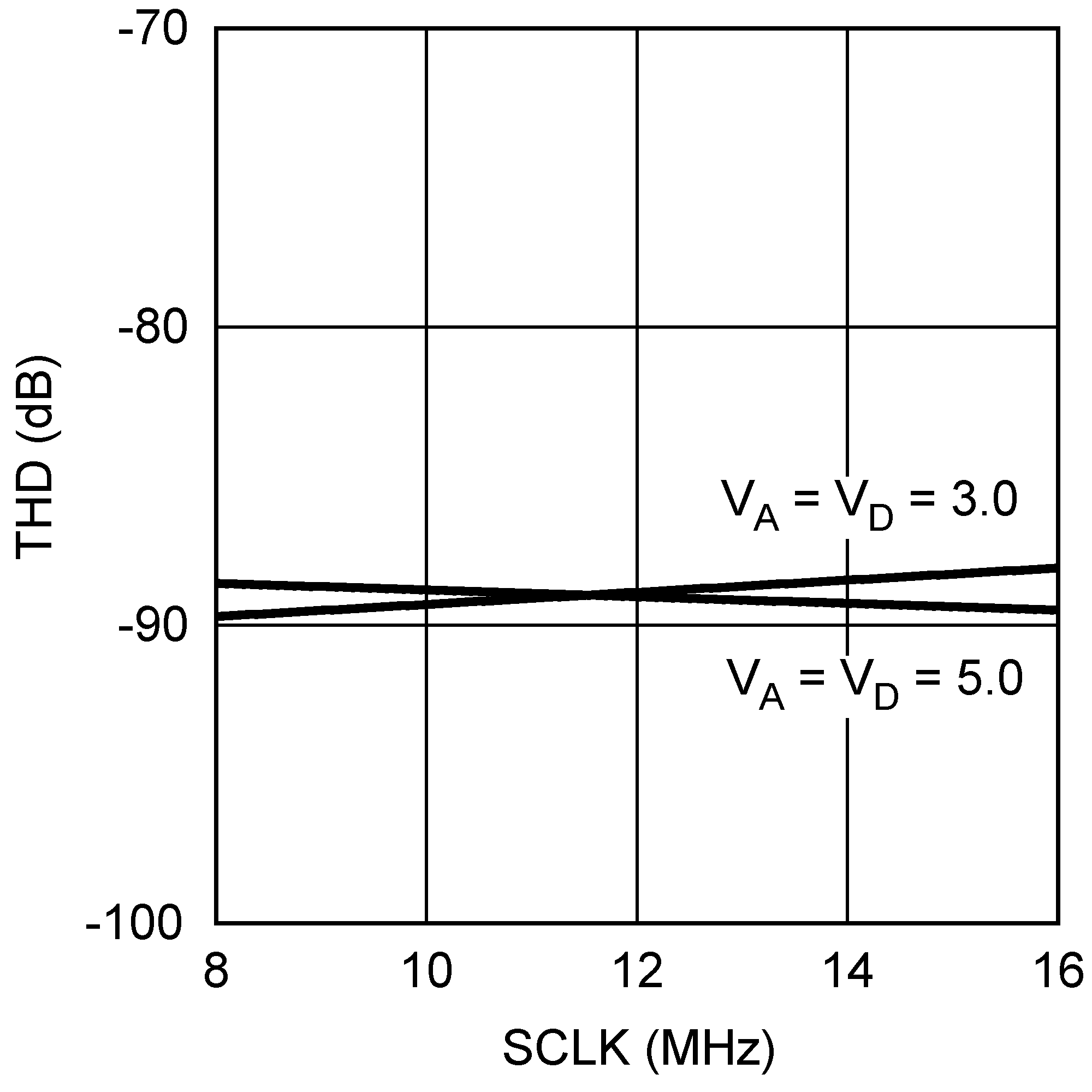 Figure 23. THD vs. SCLK
Figure 23. THD vs. SCLK
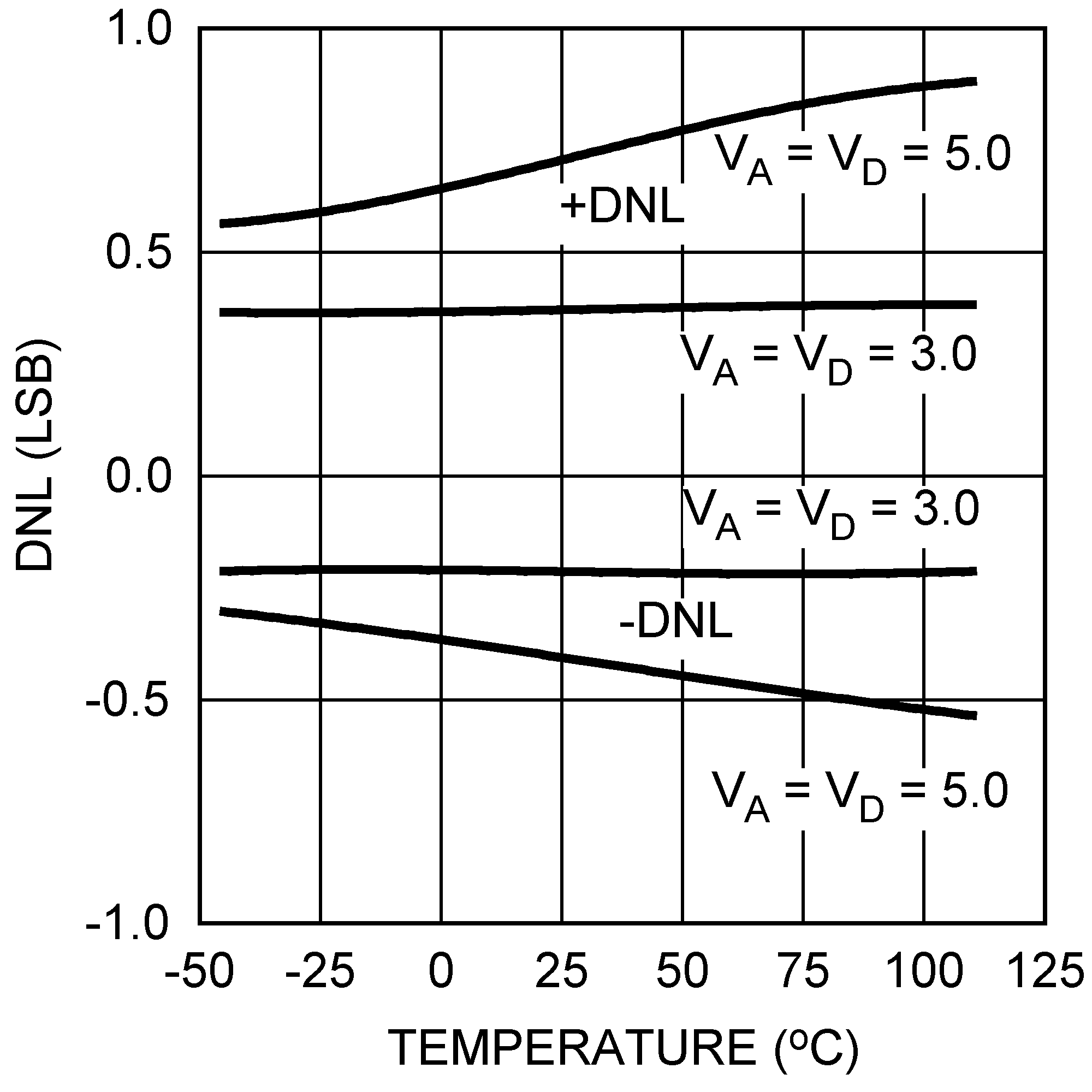 Figure 25. DNL vs. Temperature
Figure 25. DNL vs. Temperature
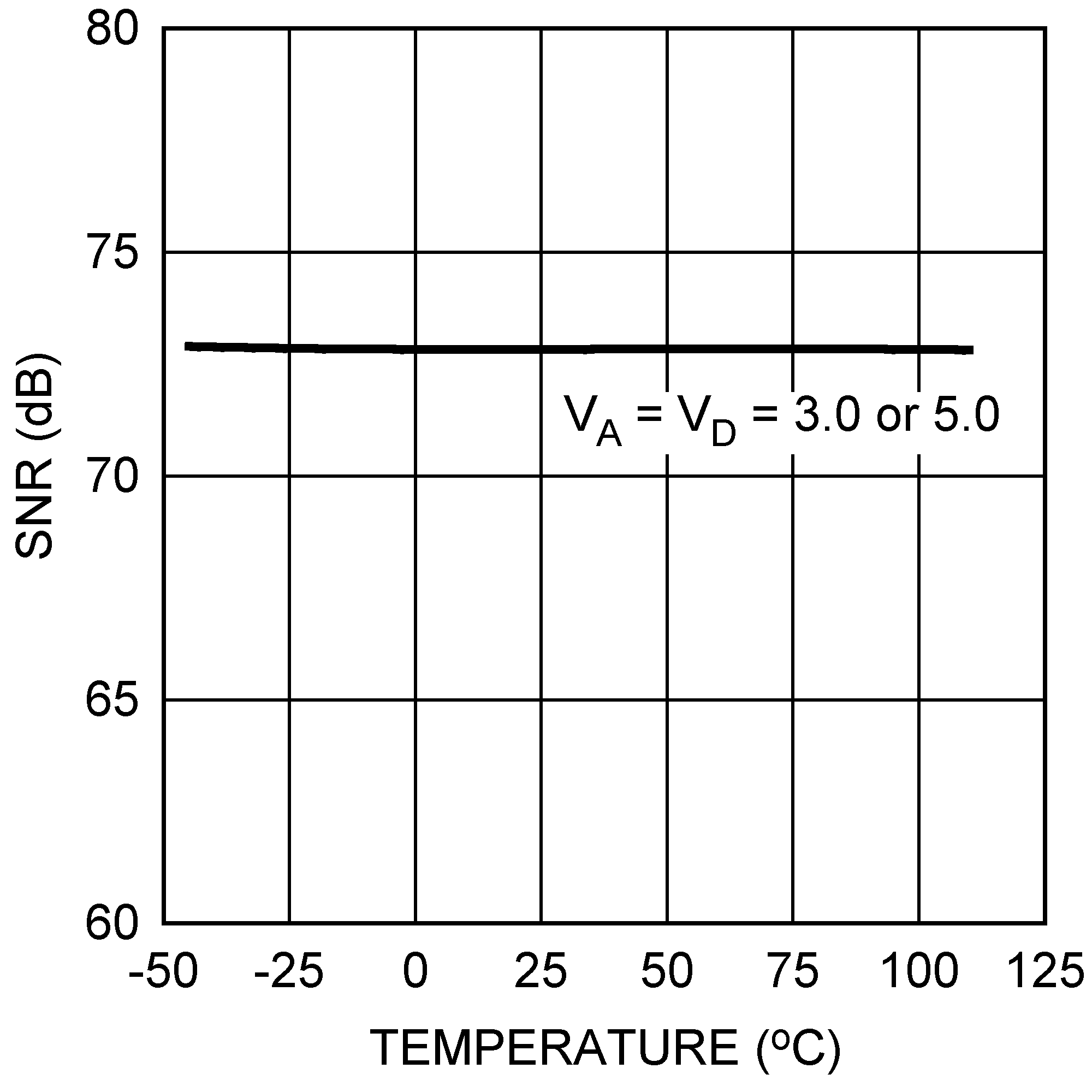 Figure 27. SNR vs. Temperature
Figure 27. SNR vs. Temperature
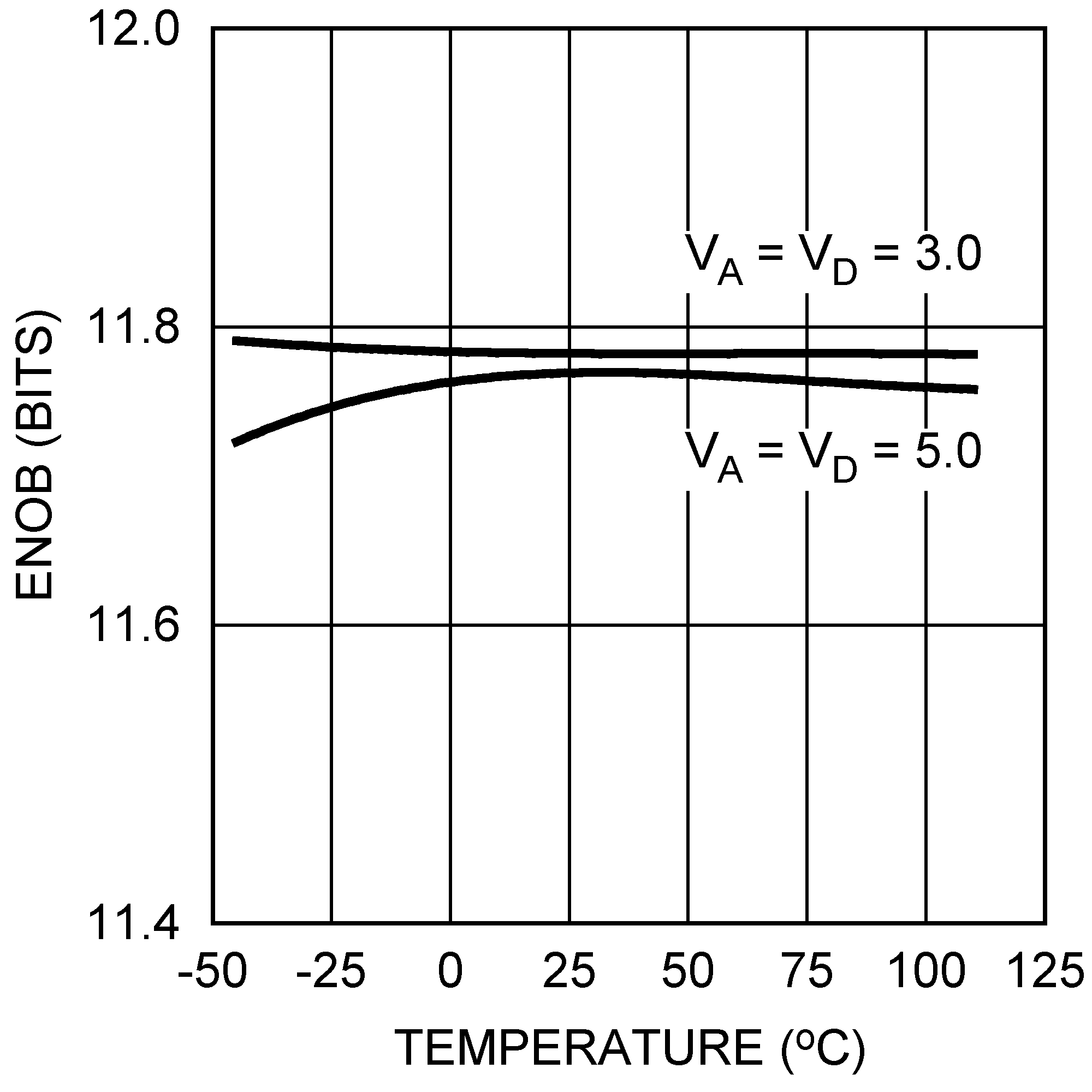 Figure 29. ENOB vs. Temperature
Figure 29. ENOB vs. Temperature
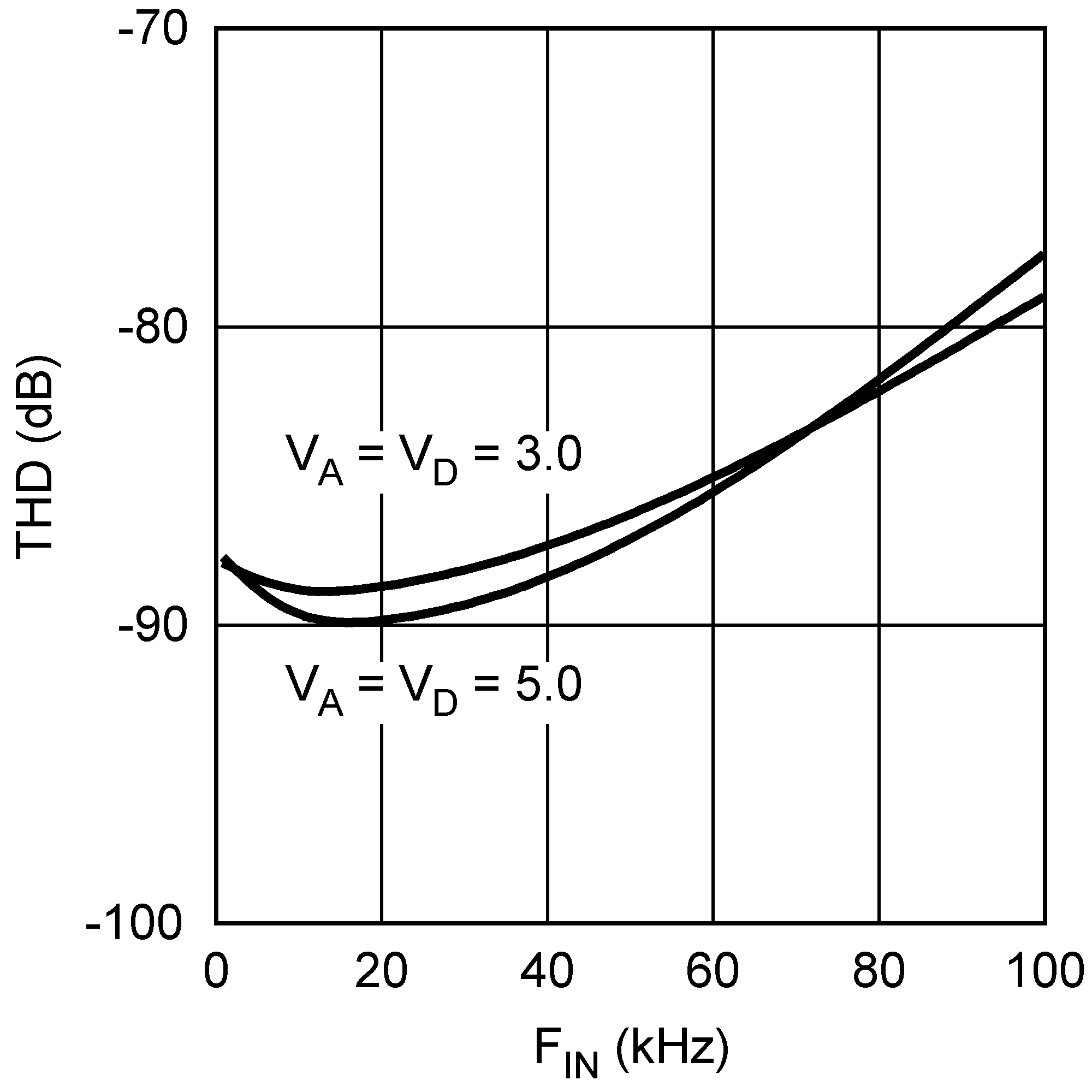 Figure 31. THD vs. Input Frequency
Figure 31. THD vs. Input Frequency
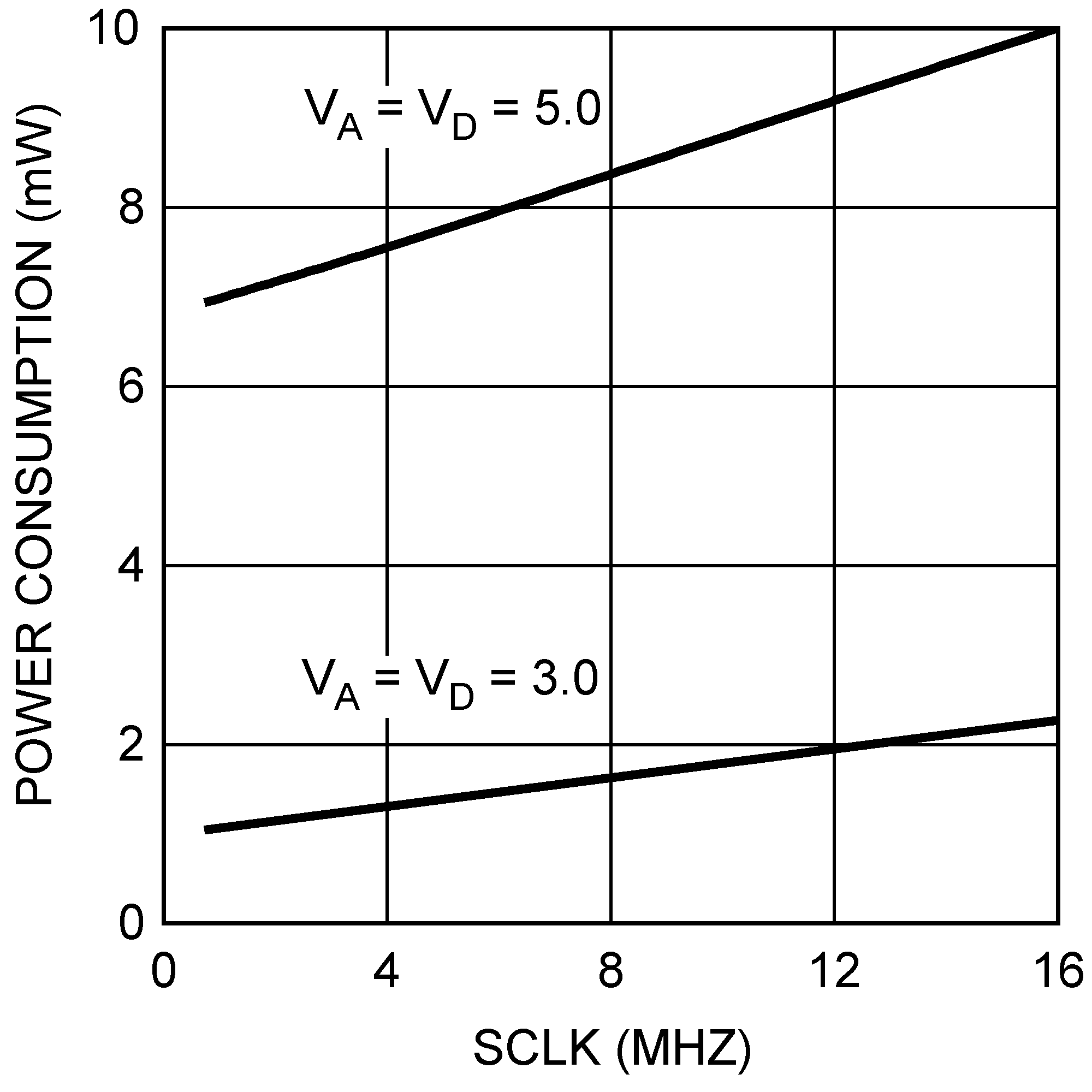 Figure 33. Power Consumption vs. SCLK
Figure 33. Power Consumption vs. SCLK